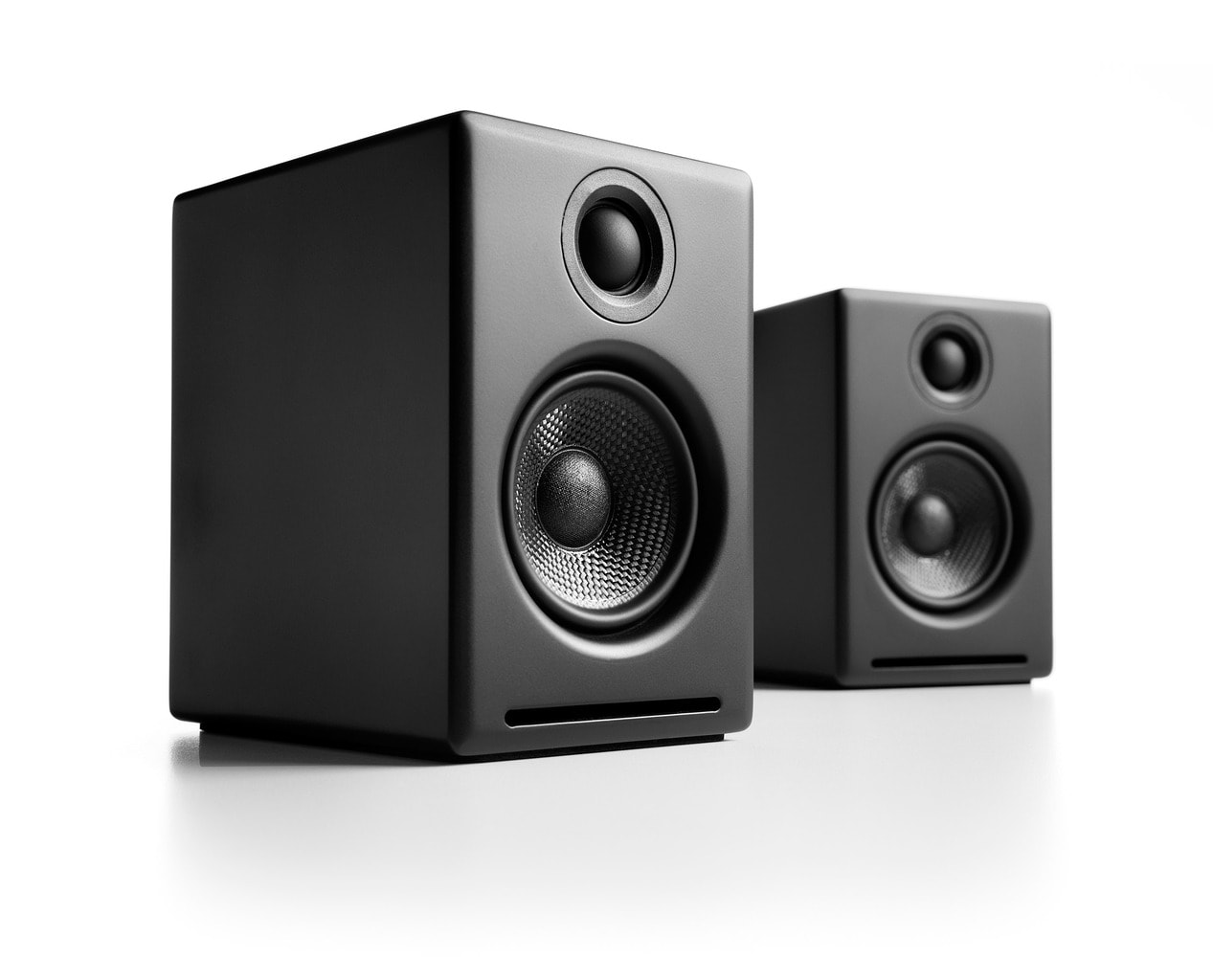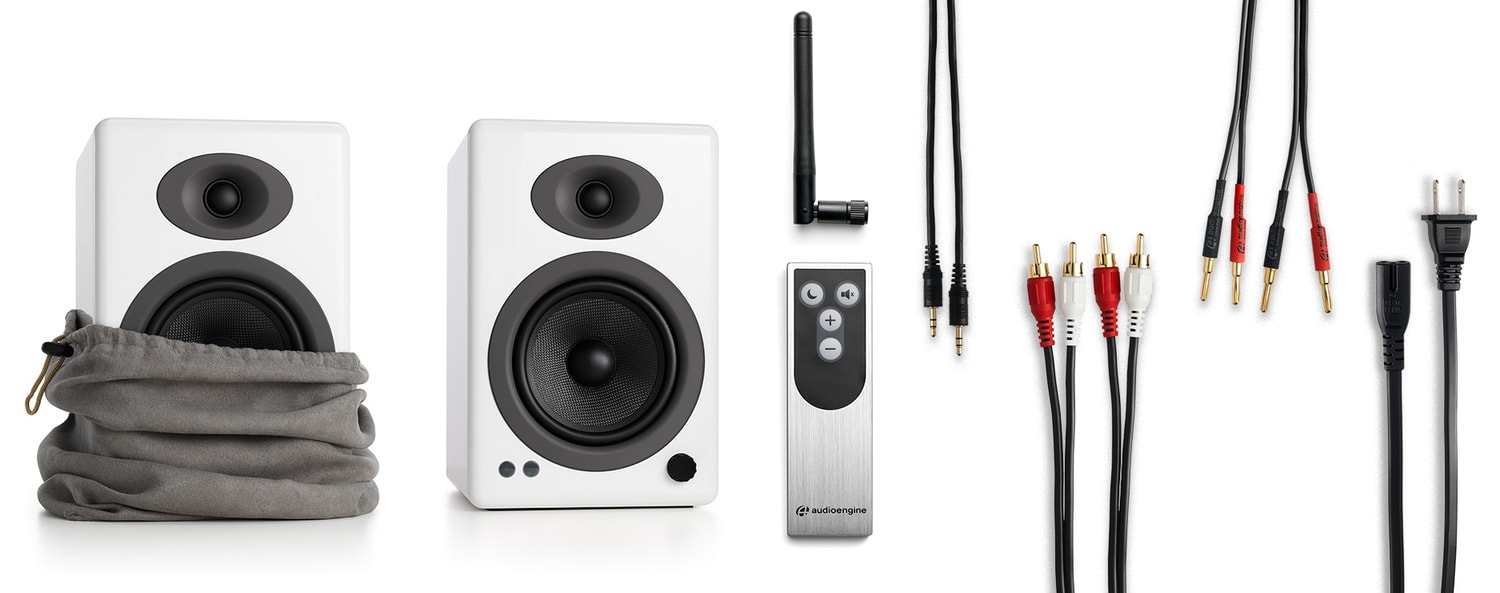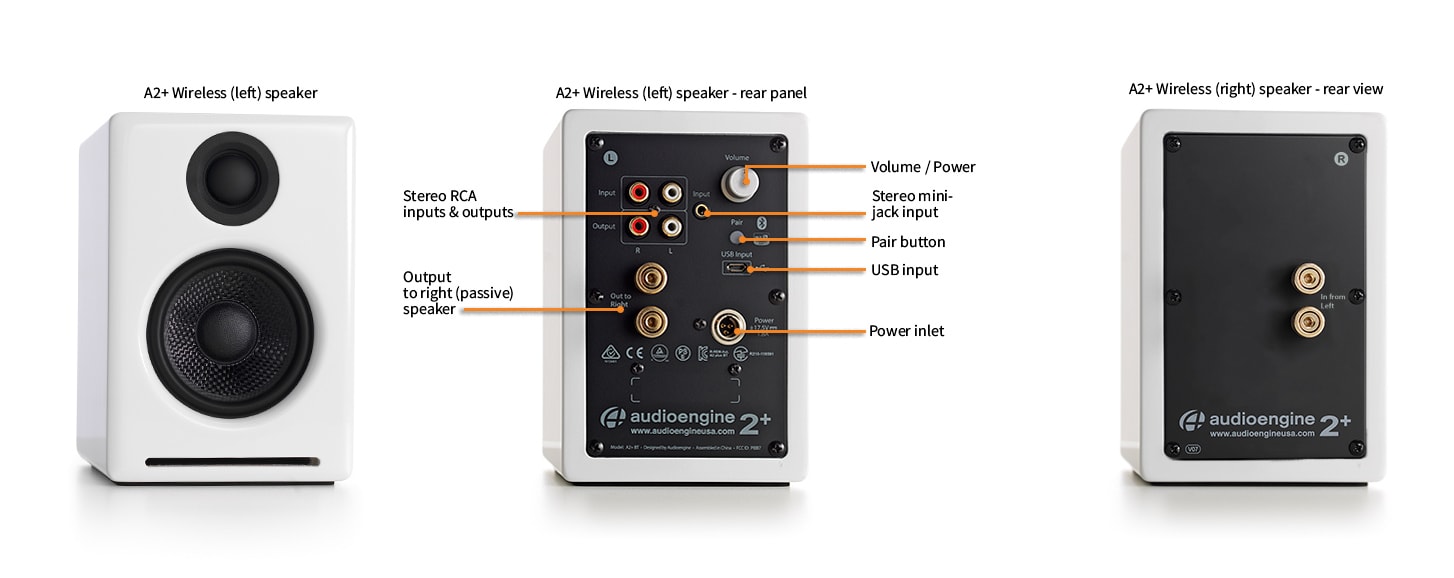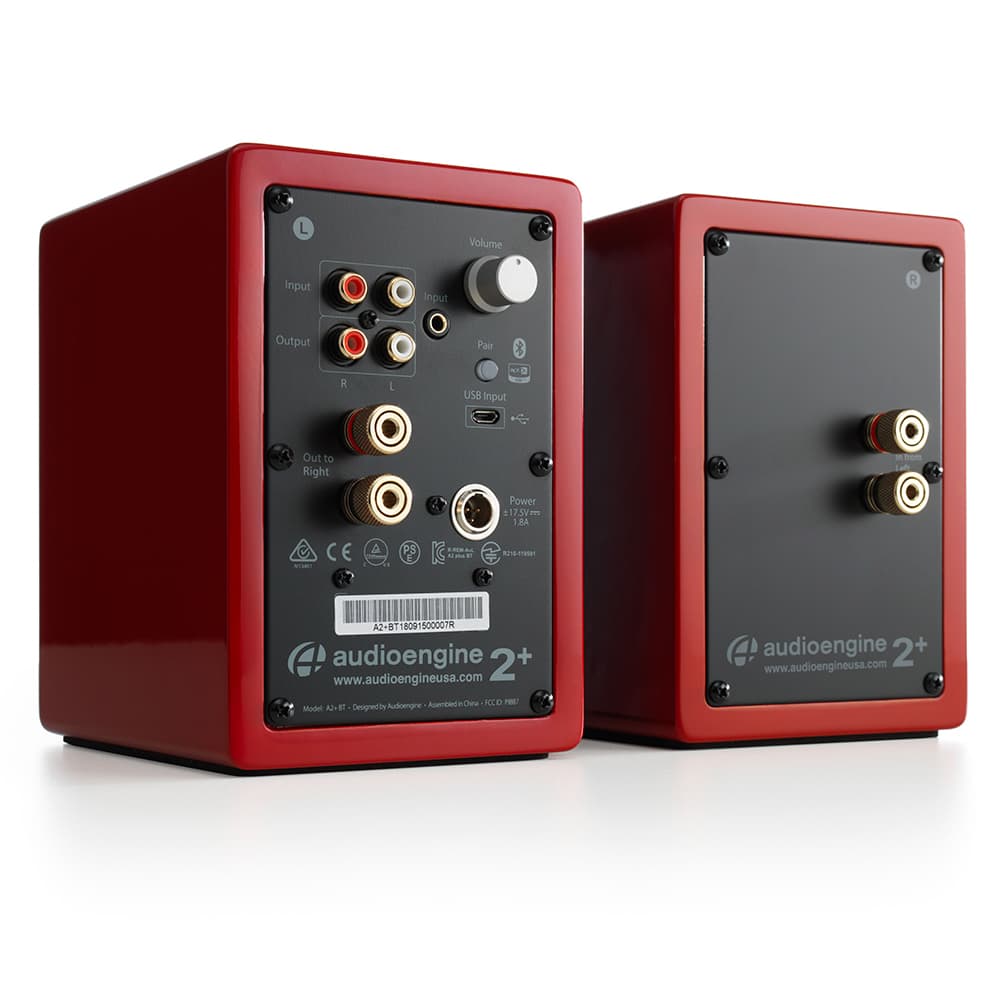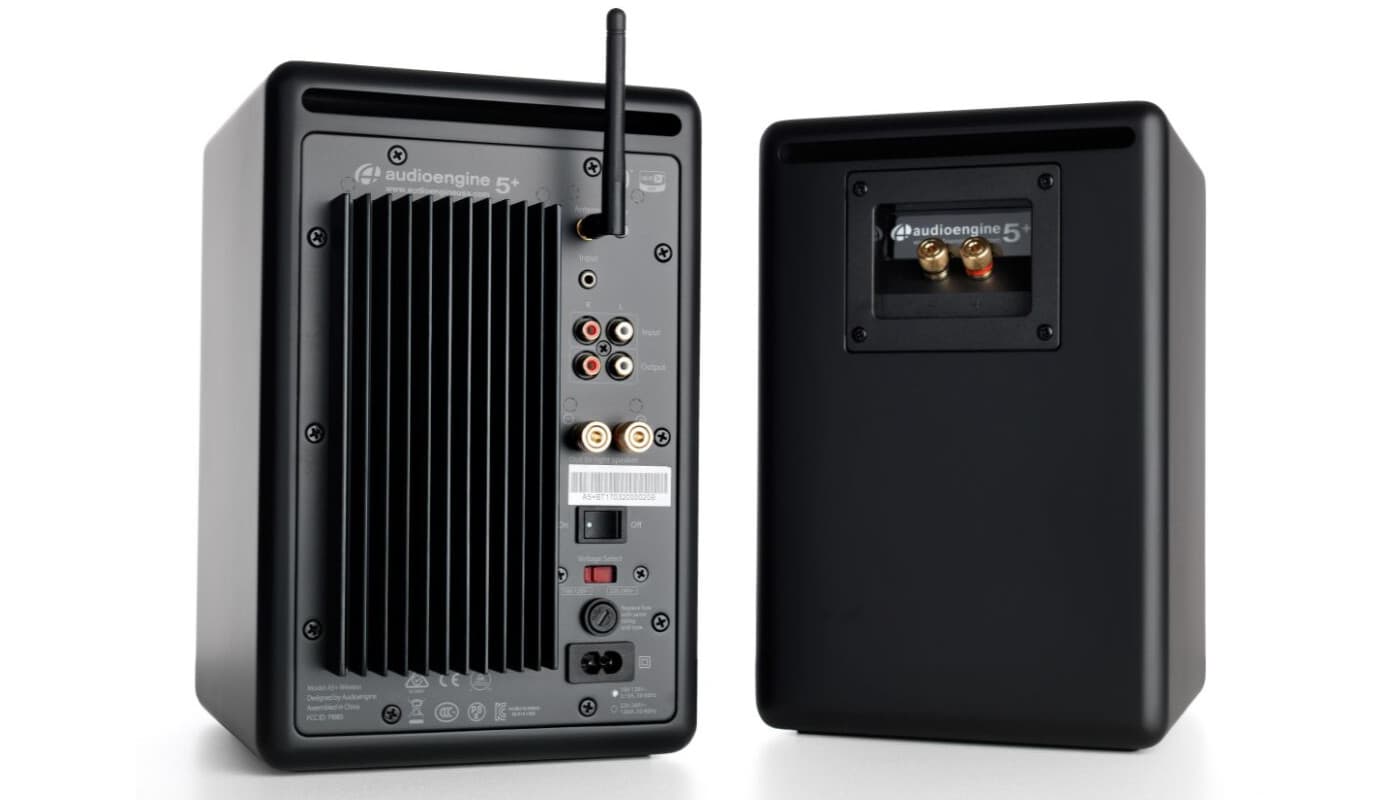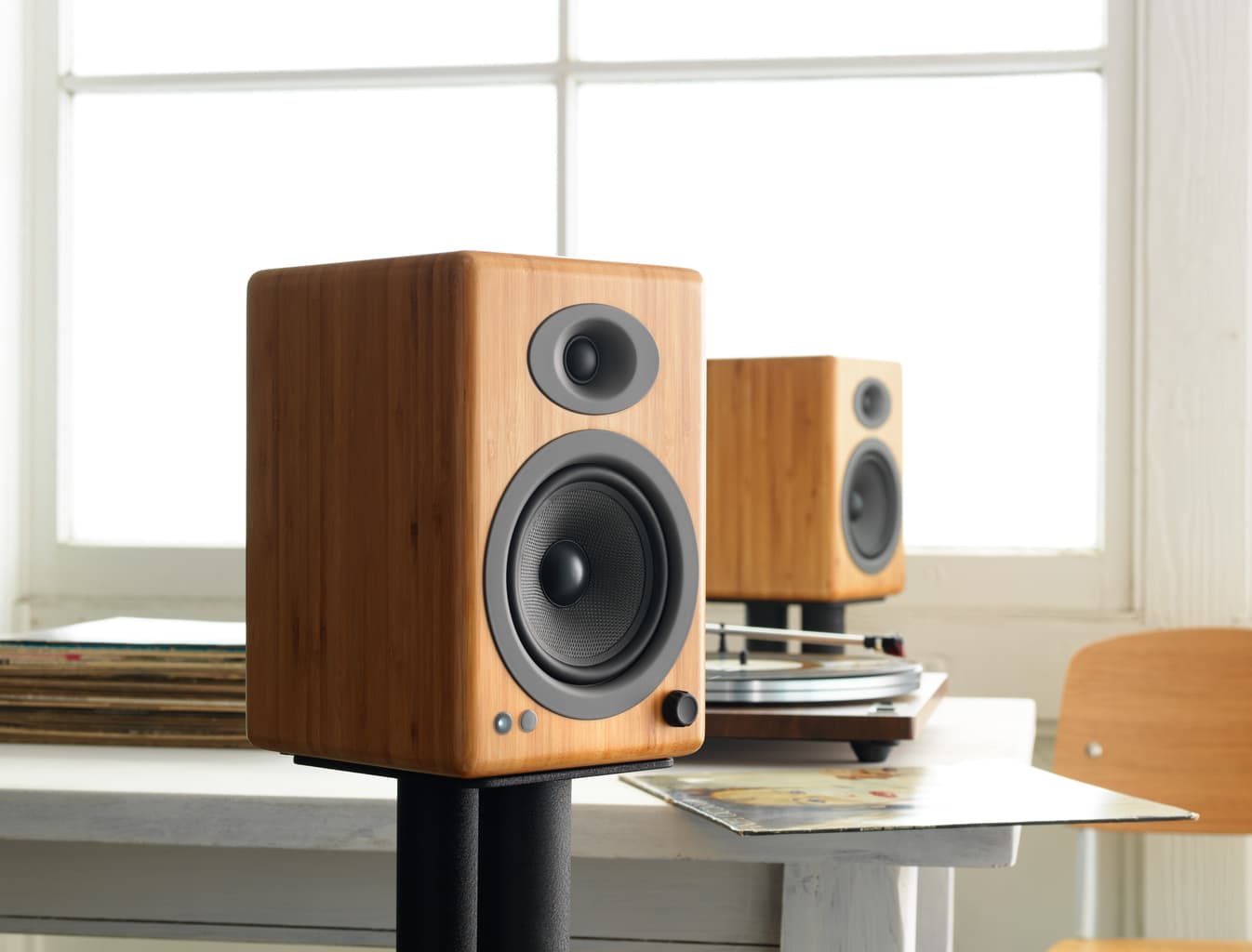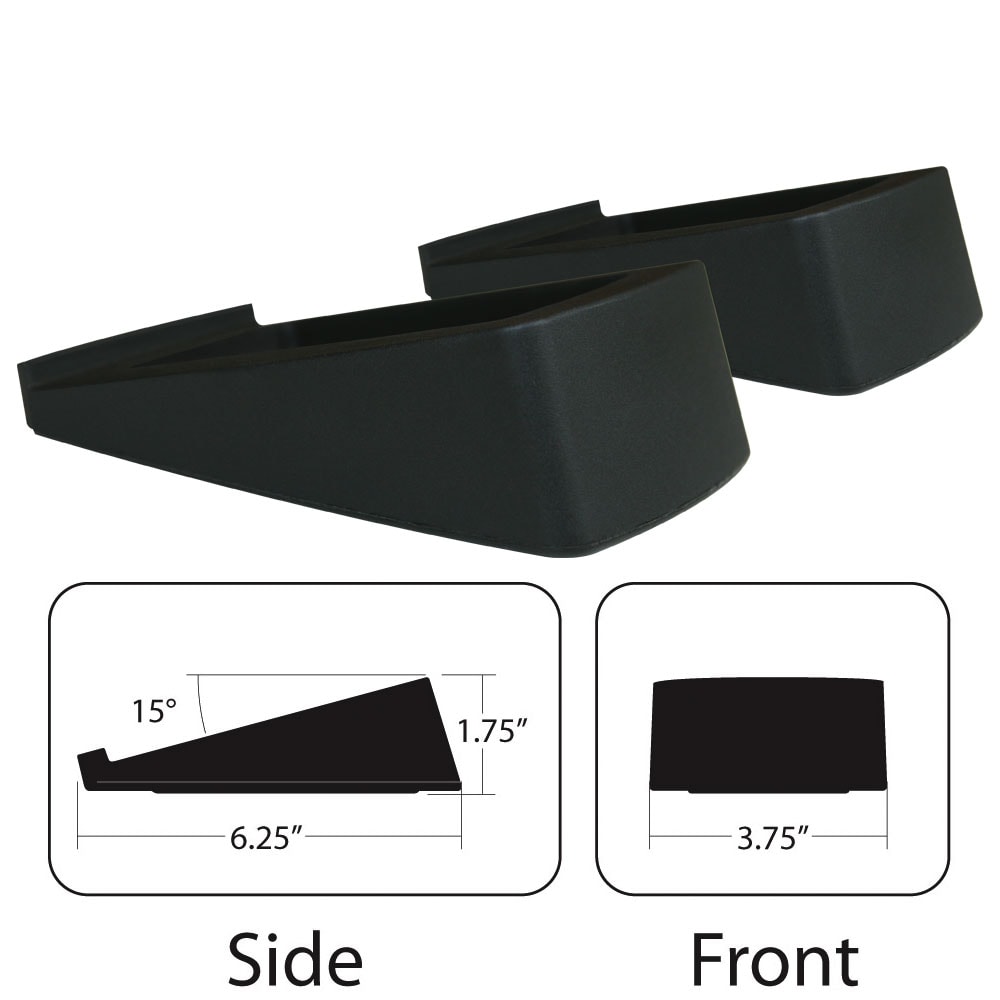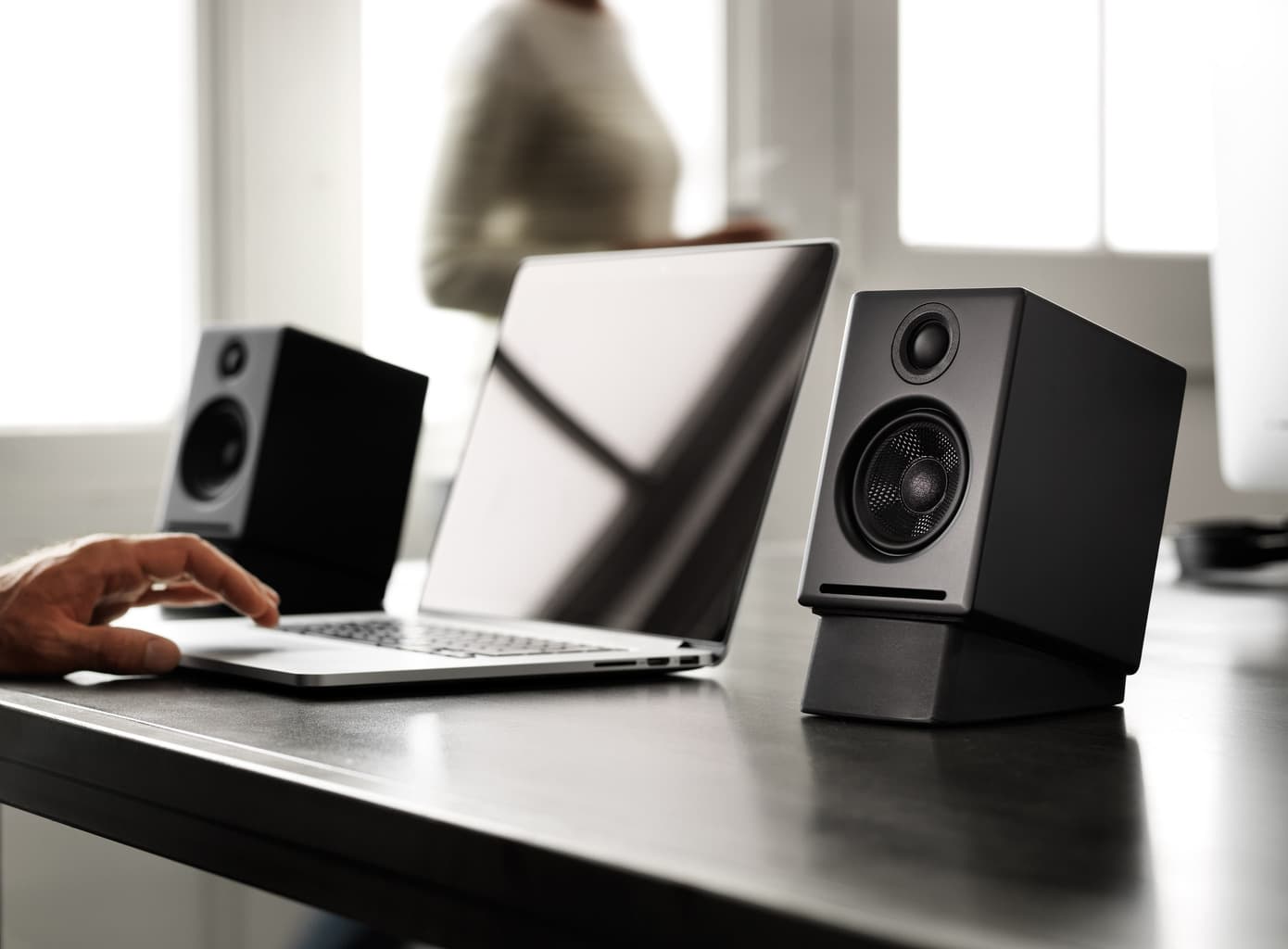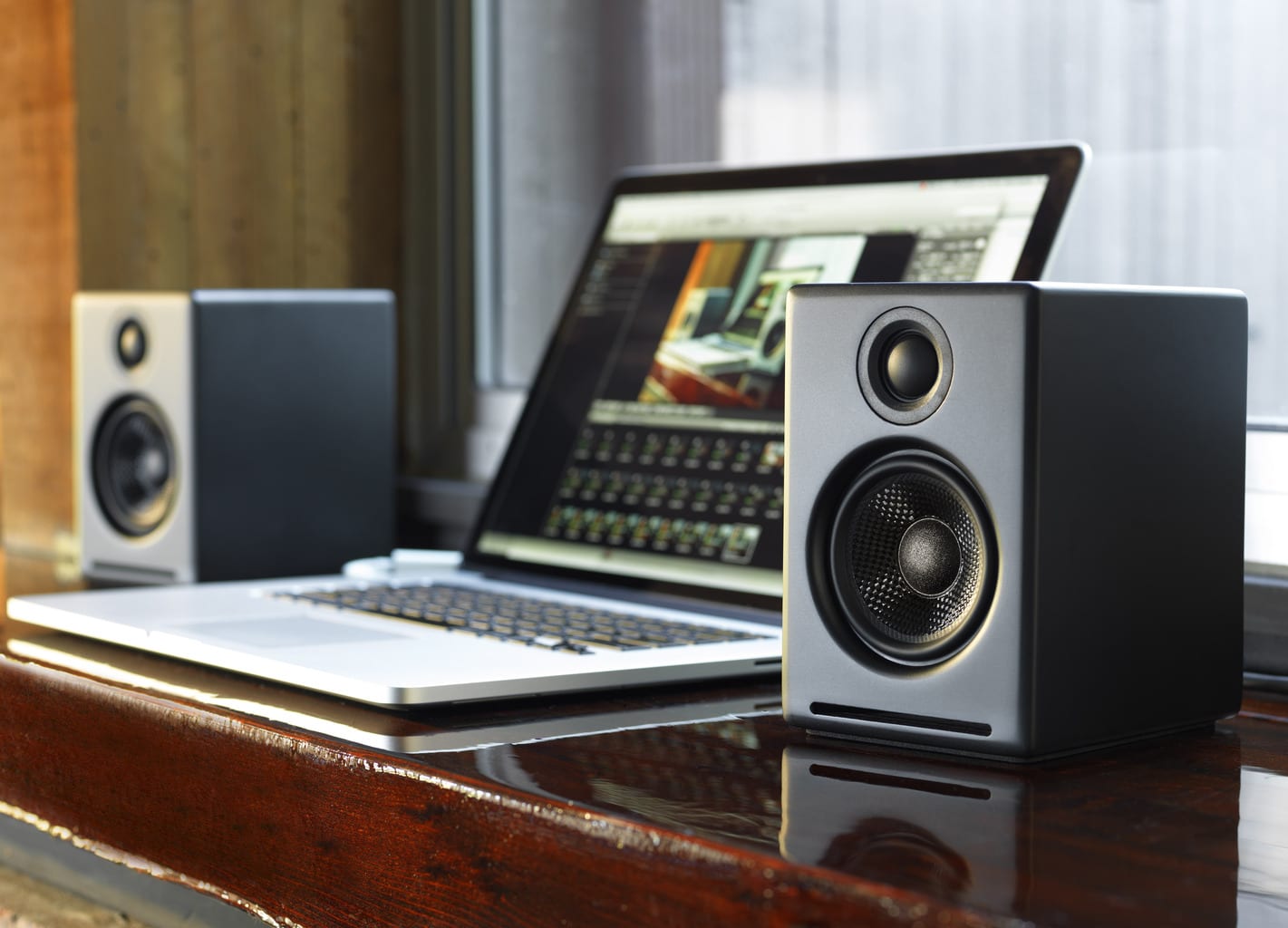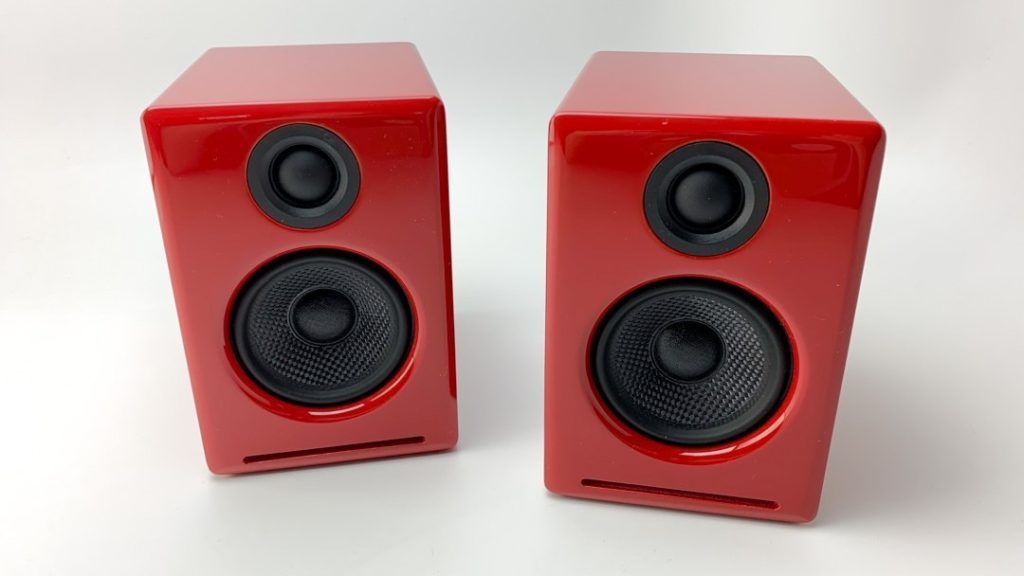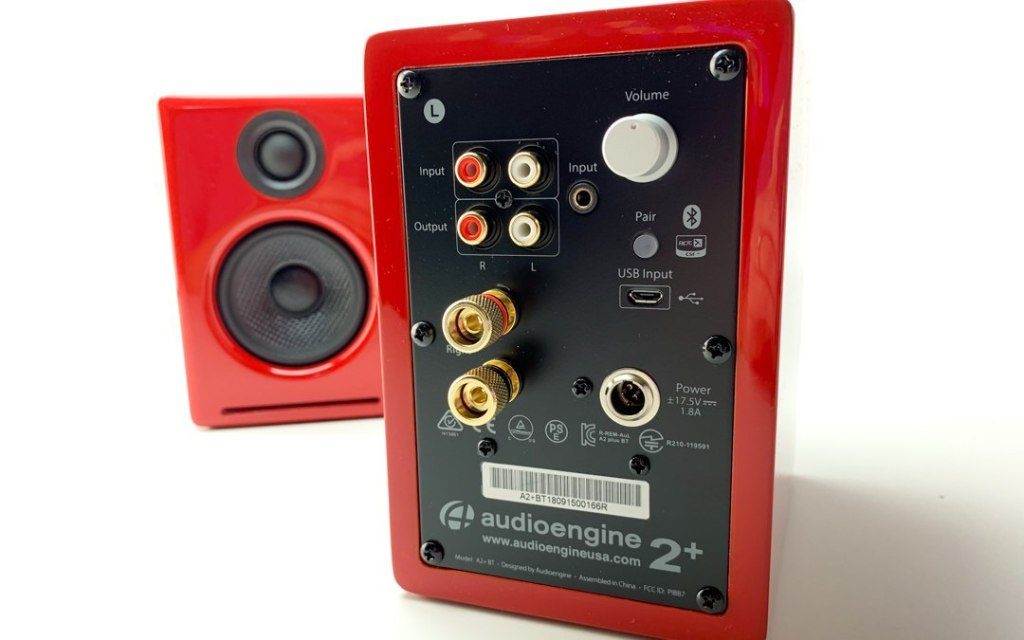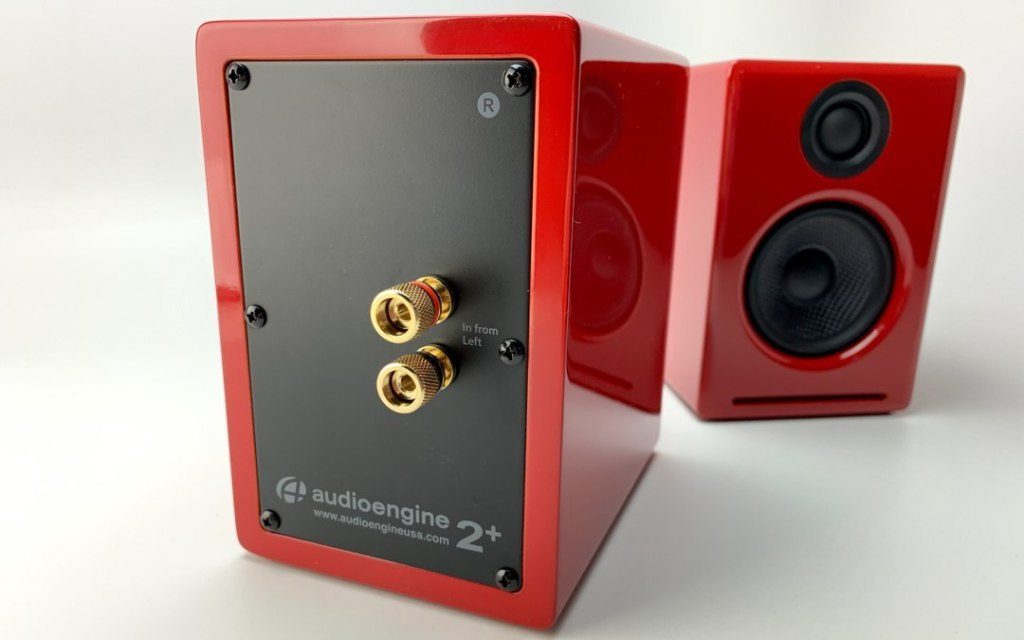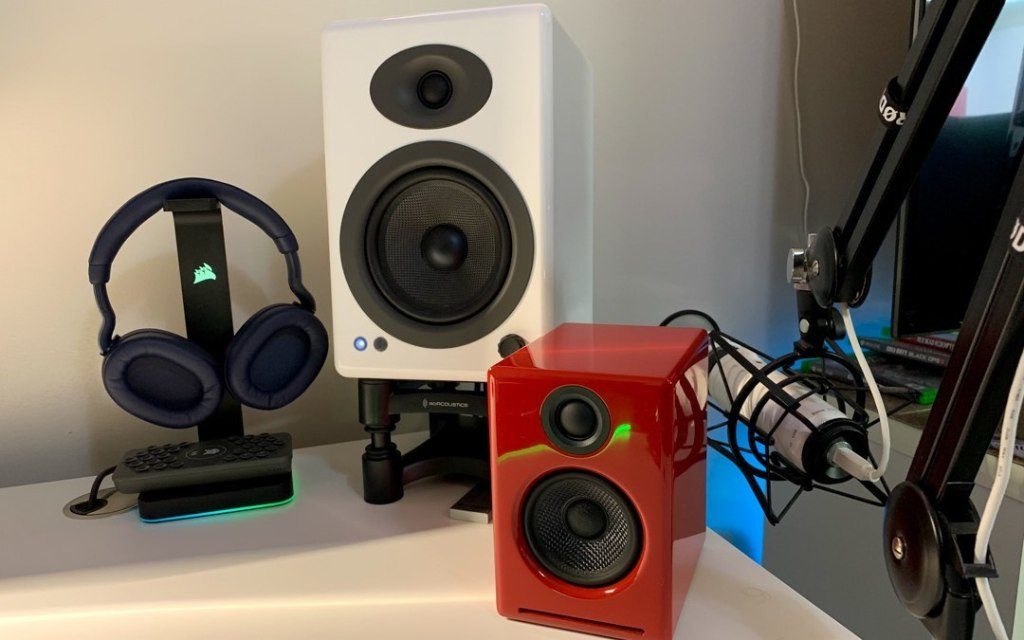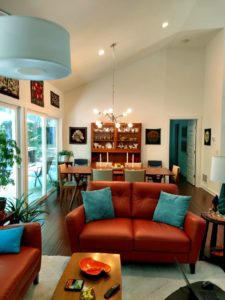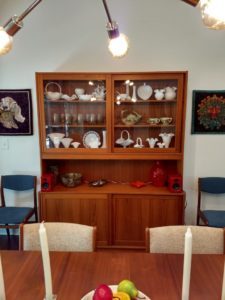They've heard Audioengine's A2+ Wireless Speakers and like us, they believe we've nailed it. Gadget Guy has rated these at 4.6 out of 5 stars. Here's what they said.
What precisely are the Audioengine A2+ wireless active speakers? Are they loudspeakers for your room? Are they for something else? They are tiny and Audioengine itself says that they have “quickly become the new reference standard for multimedia computer speakers”. So we’re going with computer speakers.
Audioengine A2+ features
This isn’t the first time we’ve reviewed Audioengine wireless active speakers. Just over a year ago we reviewed the much bigger A5+ models and were so impressed we scored them at 4.7 out of 5.0. But how would the Audioengine A2+ speakers stack up. They are so very, very tiny.
How tiny? Each stands just 152mm tall – that’s six inches – and 102mm wide by 134mm deep. The left-hand speakers weighs 1.6 kilograms, while the right-hand speaker weighs 1.4 kilograms.
Why the difference? That’s because all the electronics are packed into the left-hand speaker. It contains the two 30-watts continuous amplifiers and the power supply and the various connections, including Bluetooth. The right-hand speaker is passive. Included with the speakers is two-metre cable for driving the right-hand speaker from the amp in the left. Gold-plated binding posts on both speakers make for secure connections.
The A2+ Wireless Speaker System
Each speaker is two-way unit, with a 19mm silk dome tweeter with neodymium magnet and a 70mm aramid fibre woofer. The cabinets are bass-reflex loaded, with a slot port at the bottom front of each. There are no speaker grilles, so the drivers are visible. I reckon they look good. Check out the photos for yourself.
Audioengine is one of those companies that makes its own speaker drivers, rather than simply using off-the-shelf parts. It says that this increased control allows its designs to work together more effectively.
Audioengine A2+ DAC and Bluetooth
On the back panel of the left-hand speaker are:
- the socket for the power supply brick,
- a pair of RCA sockets for stereo analogue audio inputs,
- a pair of RCA sockets for stereo analogue audio out – these can be used for a subwoofer as well,
- a pair of gold-plated speaker binding posts – this is the output to the right speaker, which has matching gold-plated speaker binding posts for input,
- a Micro-B USB socket for connecting to a computer, and
- a level control knob.
The other input is Bluetooth. The speakers support the regular SBC stereo audio codec, as well as aptX. That means higher quality audio from those phones which support it.
There is no input selector. If you send music to the Audioengine A2+ speakers via its analogue inputs and the Micro-B USB, it’s mixed and all comes out together. If you send music to the speakers via Bluetooth, it switches off the other inputs and only plays the Bluetooth music. When that stops – even though the Bluetooth connection remains active – the other inputs come back to life.
Read full article here.
They've heard Audioengine's A2+ Wireless Speakers and they get it. Popular Mechanics has rated these as best overall when it comes to sound. And, what's more important than that in a speaker? Here's what they said.
You can of course get even better-sounding speakers if you’re willing to step up in price, but this pair from Audioengine is tough to beat while still being somewhat reasonably priced. The audiophile-minded folks at The Master Switch say they have “amazing audio and build quality,” thanks to their hand-finished wood cabinets, aramid fiber woofers, and silk dome tweeters. They aren’t lacking in features either, with Bluetooth, 3.5mm, RCA and USB inputs—not to mention your choice of black, white, or red color options. However, as we mentioned above, and this PC Mag review points out, you’ll want to make sure you angle them upward to get the best sound quality (Audioengine sells some matching stands for $29).
The A2+ Wireless Speaker System - Best Overall Sound
Read full article here.
So excited to find out about our A5+ Wireless Speakers getting mentioned in Forbes as some of the best speakers to buy. Here's what they said:
Trading a little effort for great sound, audiophiles are in luck: there are a lot of choices for computer speaker systems that sound great.
Audiophile computer speakers tend to be larger and more sophisticated than the drab little plastic boxes you may be used to. For good audio reproduction, you can’t bend physics—you’ve got to move air, which requires larger speakers for those low frequencies and more powerful amplifiers to drive it all without distortion. Digital signal processing technology helps shape the sound as well.
The A5+ Wireless Speaker System
There are 150 watts of power in the A5+ Wireless Speakers, so they’re not only good and loud, but clean, clear and distortion-free. Qualcomm aptX high-definition Bluetooth makes sure that none of that fidelity goes to waste, either. Analog inputs include RCA and a 3.5mm jack. Deeper inside is a built-in 24-bit digital-to-analog converter and class A/B amplifier. There’s even a USB charging port so you can top up your device’s battery as it supplies music for you. The A5+ Wireless Speakers are, of course, a little larger than normal computer speakers because they pack 5” woofers with aramid fiber cones and ¾” silk-dome tweeters, but the big sound makes them worth the space they occupy.
Read full article here.
Audioengine is likely one of the leading brands when it comes to bookshelf speakers. The company manufactures some excellent products all with high-quality components delivering excellent sound quality. One such product is the Audioengine A5+ Wireless Speaker System. Easily Audioengine’s best selling speaker for PCs and home stereo systems. We had a closer look at this awesome speaker to find out if the A5+ is worth all the fuss?
A5+ Design
Besides sound quality, Audioengine is renowned for its beautifully designed speakers. The A5+ Wireless Speaker cabinet is made from a medium-dense fiberboard providing a beautiful wood finish with durability to last for decades. You have the option of three finishes, satin black, hi-gloss white or natural bamboo. Personally, I prefer the bamboo finish but it all depends on which looks best with your setup.
The low-frequency driver is made with Kevlar offering excellent durability while adding a premium aesthetic. As with all Audioengine speakers, the silk tweeters are mounted stylishly to add to the product’s design features.
On the left primary A5+ (active) speaker is a volume control, IR receiver, and power indicator. Having the volume control on the front is a brilliant upgrade from the A2+ which was on the rear (why do manufacturers do that!)
The active speaker also houses the amplifier, power supply, and inputs for both speakers. The active speaker connects to the right passive speaker via a 12-foot 16 gauge speaker wire which Audioengine is kind enough to supply with the system.
Also included is a simple remote control which allows you to put the speakers into sleep mode, adjust volume or mute. This is especially useful if you’re installing the A5+ Wireless Speakers as stereo speakers in your preferred living space.
A5+ Inputs and Outputs
The A5+ allows for stereo RCA and ⅛-inch AUX inputs with a stereo RCA pre-output. No Bluetooth on the A5+ Speaker System but this is an easy fix with a Bluetooth receiver which you can pick up on Amazon for under $30. If you prefer your Bluetooth built-in, there is the option of the A5+ Wireless Speaker System which is essentially the same speaker but with Bluetooth (version 5) connectivity.
In addition, Audioengine has included a USB charge output so you can charge your mobile device from the back of the speaker. This is a great feature for desktop PC speakers as it means you don’t have to run your charger cable to a socket on the wall or floor. A small but appreciated convenience.
Below the audio inputs and outputs is a speaker output to the second passive A5+ speaker. All the connections are gold plated which offers a superior transfer of audio signal.
What Does The A5+ Sound Like?
When it comes to sound, Audioengine very rarely disappoint. If you owned a pair of the A2+ Wireless Speakers and wasn’t entirely happy with the sound, then the A5+ Wireless Speakers will likely make you a lot happier. If you liked the sound of the A2+, then the A5+ Wireless Speakers are going to blow you away!
Each speaker features a 5-inch low-frequency driver with a ¾-inch tweeter. The built-in amplifier delivers an impressive 50W RMS and 75W Peak to each speaker. That’s a 150W Peak power output. These speakers are seriously loud. If you’re using these as PC speakers at desk height, be prepared from some chest-thumping bass. The low-end is chunky with excellent definition and a nice punch to make any listening experience that much more exciting.
The mid-range is forward with beautiful clarity making vocals, instruments and special effects from movies and games come alive. The highs are bright without ever sounding harsh which is always important for a near-field speaker!
If you’re looking for a versatile speaker to play music, games, watch movies, etc., the A5+ does the job with surprising ease. You’ll be hard-pressed to find a pair of bookshelf speakers under $400 which deliver such exceptional sound for a variety of applications.
A5+ Speaker Placement – Getting The Best Audio Experience
Audiophiles often harp on about speaker placement. The truth is, it does matter, especially if you’re looking for the best sound.
Wherever you mount the A5+, make sure the speakers have a rear and side clearance of 6-inches for the best bass response. If you’re mounting the speakers on your desk, try to get the tweeters up to eye level for the best clarity and sound experience. This will also have the woofers firing into your body so you can feel that bass!
For best imaging, place your A5+ around 6 feet apart with the speakers angled into your listening position. You might need to place around with this a little to find the sweet spot, but 6-foot is a good place to start. Also, ensure you are positioned in the center with the speakers equidistant apart. Use your PC monitor as a central reference point to easily measure the distance.
What’s in the Box?
- 2 x Audioengine A5+ speakers
- Remote control
- 12-foot 16AWG speaker wire
- AC cord
- 6.5-foot RCA to RCA cable
- 6.5-foot ⅛-inch AUX cable
- 2 x cloth speaker bags
- 1 x cloth cable bag
Audioengine A5+ Conclusion
If you have $400 to spend on a pair of bookshelf speakers, then the A5+ Wireless Speaker System is definitely the way to go. The speakers look incredible and the built-in amp means no extra power amplifier or cabling is necessary.
The A5+'s good looks are only second to the speaker’s incredible sound. From your favorite vinyl records to earth-shaking sound effects in action movies, everything sounds great on these amazing speakers.
Read full review here.
Audioengine is well known for their range of speakers in different varieties. The company has been around since 2005 and is based in Austin, Texas, where the founders have spent time with the likes of Gibson Guitars, Harman-Kardon, and Apple. Besides producing high-quality speakers, the company also manufactures components like Bluetooth transceivers and headphone amps.
Over the years, their smaller computer-orientated speakers have accumulated a lot of popularity, and with the newest release of the Audioengine A2+ Wireless Speaker, they have certainly added to that. Based upon the design of the first A2, the A2+ Wireless adds Bluetooth connectivity and USB-in, so you can access the internal DAC with a cable if you have a fixed setup. With its built-in amplifiers, the A2+ Wireless Speakers function easily as a PC speaker, analog or digital source.
Design
Measuring only 6 inches in height, 4 inches in width and 5.25 inches in depth, and weighing around 3 pounds in weight it’s safe to presume the Audioengine A2+ Wireless Speakers are reasonably small. However, with its small exterior comes a beautiful design and an even more impressive sound. From a front perspective, these speakers look very neat and clean, especially in black because it blends in the drivers well. Both left and right speakers are identical from the front which give an aesthetically pleasing symmetry to your setup.
Most speakers will have to rest on somewhat cluttered surfaces, so their size and design are most welcome. The Kevlar membrane woofer and soft dome tweeter look sleek, and the front-firing port is barely noticeable as it is situated at the bottom. The A2+ Wireless Speakers also feature no grills so it has a rather less rugged finish. DS1 stands can also be purchased, which raises the speakers slightly off the ground. The elevation allows the speakers to be angled upward until you find that sweet spot for maximum audio enjoyment.
Features
Audioengine manufacturers and creates their own woofers, tweeters and many other components in the speaker systems. The custom-designed speaker comes equipped with cabinets, bass port, amplifier, and drivers all working together to provide incredible sound for a compact package. The A2+ features a ‘master speaker’ with all electronics inside, in this case, it is the left speaker, whereby you would need to run a cable from the left to the right. This feature may limit you in the way you position the speakers to get to the inputs and outputs, but sometimes it is convenient to have one master and another slave, especially where there is a short distance between the two. This approach is probably the most cost-efficient and easiest to manage for computer audio purposes. The left speaker houses all the controls, ports and the amplifier.
There is a Stereo RCA Input and output ports, volume control, stereo mini-jack input, Bluetooth pair button, USB and power inlet. It should be noted that the volume control also doubles up with the power switch on the back. This can cause some annoyance, especially when there is no remote control included. This should be fine if you only plan to use it for PC via USB-in or Bluetooth.
The A2+ Wireless Speakers' amplifiers are a conservatively-rated class A/B analog monoblock design. This traditional amplifier configuration is said to provide better quality audio and superior flexibility. All the circuit boards for the preamp and power sections are also vertically attached for maximum mechanical shock defense. The A2+ Speakers use an audiophile-quality, ferrofluid-cooled silk dome tweeters with neodymium magnets, which hold up well under high power. The speakers’ woofers are made from aramid fiber woven glass composite with rubber surrounds, aramid fiber is durable in the sense that the woofer retains its shape when being set at high levels. The A2+ Speakers are both magnetically shielded, which means they can be used as TV speakers without the worry of interaction with a monitor.
Installation and Setup
When unboxing you’ll find that the speakers are well packed and covered with a microfiber bag to protect the finish from scratches or smudges. Upon removal of all the contents you should also find two bags with a power cord and cables. Both speakers are labelled left or right, but this should be obvious as the left speaker has all the output and input controls, and a volume/power button.
The quick-start guide recommends that the speakers be placed well away from walls, which is a common suggestion for speaker designs with a bass port. Audioengine also suggests that you be on the same level to the speaker drivers, so you can get the best frequency response and imaging. Depending on how you plan to use the speakers, and what way you plan to connect, leave some space at the back of the left sided speaker. If you plan to access the controls often, volume can also be adjusted on your computer or smartphone if that is the only control you wish to change often.
Sound and Performance
Sound quality is the most important aspect behind every speaker, and the A2+ Wireless Speakers produce an exceptional result considering their minuscule design. The A2+ offers a variety of ways to connect your device to the speaker. The easiest option when connecting to PC would be through the USB port found at the back, as it avoids another ADC step in the signal chain. Once the USB cable has been plugged in, your PC should immediately recognize the device and be ready for use. Other ways of connectivity is through the implementation of your laptop or smartphone using Bluetooth. The A2+ comes with Bluetooth version 5 which provides better sound quality, further range, and increased battery life. When tested with a smartphone it was found that the connection was extremely strong, and the connection did not drop within 60 meters as can be expected with Bluetooth 5.
Compared to most medium-sized smart speakers, the A2+ Wireless Speakers can seriously deliver some power. You get a little less bass than medium-sized smart speakers, but the overall sound quality is much better. Extension is very similar with the A2+ and medium-sized ones as they both struggle below 100 Hz, but the A2+ does so without introducing audible DSP artifacts. The treble and midrange are also pretty good, however, there is a lower midrange bump. The bump is not detrimental to the presentation, but it is was probably an attempt to get a slightly more cumbersome presentation in a system that is a little light on bass. In response to this, Audioengine does still make a suitable subwoofer for the A2+ speaker.
“in small spaces, these speakers are the perfect option”
EDM and Rock music sound great, even though the 3 to 5 kHz range is not overly pronounced. Female vocals are crisp without being too forward, and the sibilance is not a problem unless present in the recording. Around the 10 kHz mark, the A2+ falls short and sounds somewhat uncontrolled. In small spaces, these speakers are the perfect option, and Audioengine has been nice enough to include a sub out on their speakers, so you can upgrade to more bass. In larger areas, however, the A2+ wouldn’t be able to compete with bigger stereo sets, which should be expected from pc orientated speakers.
Audioengine also sells the DS1 desk stands, which help you position the speakers to find that sweet spot. Other desk stands will probably give you the same result, but the DS1 stands feel more secure despite being made of plastic. To find the sweet spot you’d want to have your ears on or slightly below the axis of the tweeter for maximum performance. The sweet spot does not necessarily provide range for everyone, so they speakers are more for a single listener, unless you’re sitting side by side.
Specifications:
Pros & Cons
- Good build quality and finish.
- Compact size for desk saving space.
- Great sound quality considering the physical size.
- A variety of sources, using analog inputs, USB components or Bluetooth.
- 3 year warranty.
- Could have a little more bass.
- High end extension can be a little unstable.
- DS1 stands and remote control should be included.
- A subwoofer should be offered with the package.
Conclusion
Audioengine's A2+ Wireless Speaker System is a small speaker pair designed for use as a computer speaker or for smaller rooms. They shouldn’t be compared against large floor standing speakers or flat panels. Taking into all these factors, they are very musical and perform great considering their price and size. These speakers are not designed to fill a living room with sound, but in a smaller room, like a bedroom or office, they sound much bigger than they actually are. It should be noted that the larger the room these speakers are placed, the more the bass will get lost and the midrange will prevail.
It would have been nice if a remote was included and that the power button and volume button weren’t the same, but these are small sacrifices for an overall outstanding product. In conclusion, there are larger speakers that cost the same or are slightly more than the A2+ speakers, that also sound exactly the same or even slightly deeper in the low end. Therefore it would be hard to find something that sounds better at this size.
Read the full review here.
The Audioengine A2 speaker system has been on “the scene” as long as the iPhone has been in existence. Though the iPhone has seen many iterations (and features, like a headphone jack) come and go, the Audioengine in my memory hasn’t changed much since it’s fall of 2007 release. What is new for the A2+ Wireless Speaker System is the addition of Bluetooth aptX.
What remains the same, and thankfully so, are the many features of the original A2 design that initially made it a hit, and kept the A2 platform in the conversation about desktop audio solutions for over a decade. It’s worth noting that Audioengine still opts to use an all-analog, 15-Watt per channel (30-Watt peak) Class A/B amplifier in the A2+ design, where just about all other self-powered speakers in this category settle for small, cool-running digital amplifiers. These digital amps can sound good-enough but just don’t have the “magic sauce” that true analog Class A/B amplifier designs bring to the table.
Also remaining are the .75-inch silk dome tweeters and 2.75-inch aramid (see Kevlar™) woofers, and front exiting transmission line (slot) ports. It’s the combination of these fast moving, light-weight, and rigid woofers in concert with the slot ports that allow the small enclosure to play well below the A2+ visually predicted frequency range. Audioengine doesn’t use any “bass enhancing” circuits to artificially add bass, so what you hear with the A2+ is all-real and astonishingly deep with the right placement.
On the front of the Matte Black (also available in Gloss Red and Gloss White) painted Audioengine A2+ Wireless Speakers sent in for review is well, nothing. Nothing other than the requisite speaker drivers and the subtle wave-guides that surround them. The look of the front baffles of these speakers are identical, and clean. A nice feature for those with a propensity towards OCD tendencies. Around the back of the (Right) speaker, a single input-pair of gold plated five-way binding posts that will accept banana plugs, spades, or bare wire. The (Left) has a single output-pair of the same gold plated five-way binding posts, along with all of the inputs (power and signal) and controls. The volume knob on the (Left) speaker has two functions, volume being the obvious one, but also as the mains power switch which can be denoted by tactile click of the volume knob. Because of this combination of volume and power, I decided that my best philosophy of use was to leave the speakers in the ON position and set to a volume that best suited my listening needs (75%), all while adjusting volume at the source level.
Analog inputs (and outputs) on the rear of the (Left) speaker begin with two sets of RCA’s one for input signals from line-level sources, and the output line-level for use with anything your imagination can surmise, but my guess is for a subwoofer. However in my review, I never found the need for one. Also included is an alternate analog input via 3.5mm (1/8th) mini-jack.
Digital inputs begin with the newly added Bluetooth aptX (and pairing button), along with the mini-USB digital input that was added back in 2013. The inclusion of a built-in Qualcomm CSR8670 Digital-to-Analog Converter (DAC) capable of 16-bit/48kHz in the Audioengine 2+ allows users to bypass a computer’s headphone output and send music directly through USB (or now Bluetooth) for improved sound.
Installation
Unboxing and setting up of the A2+ Wireless Speakers was rather straightforward. The speakers were packed in cloth speaker bags, along with a cloth bag for all the included cables. Cables included a ground-free power-supply-cable-combo (12ft), solder-tipped (bare) speaker wire (16ft), a 3.5mm audio cable (5ft), mini-USB cable (5ft). Also included, a quick-start guide set of notable setup instructions and safety warnings, along with a complete brochure of Audioengine’s product line.
As for setup, I first decided to let the speakers break-in for the recommended 4-5 hours at moderate levels before settling in for serious listening. My initial placement was in a small listening room, placed on speaker stands about 7ft apart, with a listening position equalling 7ft from the front baffles of the speakers. For the remainder of my listening sessions, I found the desktop placement to be where I experienced the best results.
Impressions
First up was the in-room placement on speaker stands. With the front baffles starting out at 24-inches from the back-wall, bass was just too far gone for this placement to be worthwhile. Once I moved the speakers back to around 12” from the back-wall, and moved my listening position accordingly, bass improved remarkably. These speakers do benefit from wall reinforcement when it comes to bass. Though improved, I found the in-room position to leave much in terms of serious listening to be desired. As environmental sounds sources, the Audioengine A2+ work well to integrate into my living space’s decor. Never calling any visual attention to themselves, and succeeding at presenting a clean sound for passive in-room listening.
For the rest of my listening, I felt it best to move to a speaker placement where I assume most users will have intended to use them, at a desktop and in the near-field. As for inputs, it worked well to compare them to one-another. First up to bat was the 3.5mm analog input, sourcing FLAC files from an iPod Classic. This input responded as I expected with only the slightest noise creeping in from the iPod itself when the iPod was connected to a charging base. When the iPod was running solely on battery power, the noise issue was resolved. I swapped cables, and used the iPod again with the RCA line-level inputs and noticed the volume on the two inputs to be the same. Which leads to one gripe I have. The input level of the analog inputs is rather low by comparison to the Bluetooth and USB DAC inputs. But that’s only a nit-pick.
Moving on to the Bluetooth and USB DAC inputs yielded really fun and great sounding results. The Bluetooth aptX module did have a good range, even when the connected mobile device was located in another room. Using the USB DAC offered up a cleaner and complete picture of what this speaker system could do. Albeit the performance of the Bluetooth input was eerily close to the USB input. The Bluetooth feature shines on the new A2+ Wireless Speakers as it’s almost indistinguishable from the wired USB input. Given the option, I had no qualms about switching back-and-forth between USB and Bluetooth for convenience, and found some of my best listening happening with both.
As far as comparisons go, I had the much larger Kanto YU6 on hand which feature 5.25-inch woofers, 1-inch tweeters, large rear ports, and 50-Watts per channel of Class-D amplifier power. At first you would think this would be an unfair fight, but this duel takes place in an arena of near-field. In-room, the larger Kanto YU6 trounce the smaller A2+, but up close and personal the A2+ provides cleaner and more taught bass, though not as universally deep. The treble and midrange of the A2+ are more balanced for near-field monitoring, and less edgy at the top end. Furthermore the use of Class-A/B amplifiers in the A2+ deliver a near-field presentation that is quite and dark, whereas the Kanto YU6’s Class-D amplifier produces audible noise that cannot be overlooked or ignored. All of this equating to a win for the A2+ in most desktop environments.

Inference
Bass on the A2+ Wireless Speakers are powerful, fast, and dig deep for their diminutive desktop friendly size. Treble and midrange are in nearly a perfect balance, and tonally reach into what I call neutral territory. Extension and power is clean and free of distortion as I go up the volume scale, and with my full intention of exposing faults, I find none. I can’t state it enough, but I really did push these A2+ hard, and with evermore complex material I pushed their way, at no point did I feel they were strained, grained, or wincing. The kick and impact of the little A2+ Wireless Speakers is quite astonishing. The use of Class A/B amplifiers is apparent as their operation yields a dark and noise-free background, requisite for nearfield listening. The transmission line (slot) ports exhibit no audible chuffing, and the woofers no evidence of cone break-up. Overall the Audioengine A2+ Wireless are still king of the hill in their category, and with the addition of Bluetooth add a jewel to their crown. Highly recommended.
Read the full review here.
It’s a real shame that bookshelf speakers have gone out of style. Although they’re fairly big and bulky, bookshelf speakers are awesome! It’s a classic look that has the potential to deliver great performance in a neat package. The Audioengine A5+ Wireless Speakers take the classic bookshelf look and pack it with in-house hardware and modern wireless tech.
Overview
- Price: $499.00
- Wattage: 150W (50W RMS, 75W peak per side)
- Connectivity: Bluetooth 5.0 (aptX, aptX HD, AAC, SBC), 3.5mm, RCA
- Dimensions: 27 x 18 x 20 mm (23mm on the left unit)
- Weight: 15.4 lbs left, 9.6 lbs right
- In the box: speakers, remote, antenna, 4m speaker wire, AC cord, 2 meter RCA cable, 2 meter 3.5mm cable, microfiber speaker and cable bags
The A5+ Wireless Speakers are almost identical, though the left houses a few extra features. There is a status light and an IR receiver side-by-side with a volume knob nearby. The status light is coated in darkened plastic so it’s dimmed and diffused.
On the back is where you see the main difference. The right speaker contains just the drivers in the cabinet, with the bass slit up top and the two banana jack receptacles for the speaker wire connecting the two speakers together.
The left speaker has a massive heatsink that houses the dual class AB analog amplifier and keeps it cool. All the connections are there as well, such as RCA and 3.5mm inputs, an RCA output for a sub, the output banana jacks, a power switch, a voltage selector, a fuse, and the AC power inlet. Under the bass port you’ll find a Bluetooth antenna and a pair button. The inputs can be used simultaneously; there is no switch.
Notice how there isn’t a single logo on the front, sides, or top of these speakers. It makes for a wonderfully clean look.
Build quality
Build quality isn’t important for stationary speakers in the traditional sense. A good feel is irrelevant, since you won’t really be touching them. However, quality materials and assembly make a massive difference in audio performance. And of course you want them to look nice!
The A5+ Wireless Speakers are made out of handcrafted 1/2-inch thick wood (MDF) and finished in either satin black, gloss white, or carbonized bamboo if you want to spend a little extra. This is the gloss white model, and despite being bookshelf speakers (which generally look rather average), the round corners and gloss white paint really look beautiful and modern. I love the choice of gloss finish.
Everything about these speakers is well put together. The cabinets are extremely solid. The back panels are properly fastened without any flex. The connectors are high quality. Of course, this is all stuff you’d expect to be done right.
The volume knob on the front is tight and has a satisfying resistance and click. It also pushes in to put the speakers to sleep.
The remote is something special. It’s made out of a single piece of milled-out aluminum with a brushed finish and heavy texture. It’s surprisingly solid feeling and the chamfered edges make it feel oh so premium. The buttons themselves feel just a bit cheap though.
To change the battery, you have to pop out the entire center remote section with a SIM tool or paper clip, revealing a bright red circuit board with an Audioengine logo and a coin cell battery. Inside the housing are four magnets that hold the board in. It’s definitely super cool and the attention to detail should not be overlooked.
One detail I quite like is that the speakers come in really nice microfiber speaker bags. The cables come in their own little microfiber bag. This is great for transporting them, but even if they’ll remain stationary, it’s a really nice touch.
Sound quality
There are a lot of different types of speakers on the market. Some are rugged, some are portable, some are straight up art. But the Audioengine A5+ Wireless Speakers are all function. Bookshelf speakers usually are.
And let me tell you, they sound amazing. The sound signature is relatively flat and balanced yet still sounds interesting and fun enough for regular people to love it.
Audioengine utilizes custom aramid fiber woofers, silk tweeters, and a dual class AB analog amplifier. The analog distinction is important, as most amps these days are digital. The debate between digital and analog will never end, but many say analog is superior in many use cases. It’s also nice to see all custom parts engineered to work together rather than off the shelf parts.
When at very low volumes, they sound flat and accurate. They’re one of the most “accurate” speakers I’ve ever tested, while most others are heavily colored, with boosted highs or bass. At very low volumes they’re almost a little clinical. This is usually augmented with a standalone subwoofer, which these speakers don’t need but can utilize thanks to an audio output for this purpose. I firmly believe a powered sub isn’t necessary here, but if you want it, Audioengine does sell the S8 Powered Subwoofer for $349.
When you turn them up, they really come alive. The bass is shockingly strong. For strong bass you’d usually see massive dedicated woofers and big ports, yet these speakers do without all that. You can get rib-shaking bass from these things with no tweaks to the EQ. And no matter how high you turn them up, they stay clear and sharp.
And they go loud! It’s easy to fill a medium-sized room with such loud sound you can’t yell over it. Distortion is basically nonexistent, too. Highs are sharp and accurate but never grating, and mids are full and powerful. It’s really a lovely sound signature and a breath of fresh air when every other speaker turns the treble up to 11 and the bass gets muddy from boosting.
They’re not just great for music either. Gaming on them is a pleasure. Gears of War (a game with wonderful sound design and incredible sound effects) especially sounds amazing, with punchy bass from every explosion and a sharp smack when you hit a wall after a roadie run.
Keep in mind that your source signal matters here. These are fully analog speakers, so your source signal is what gets amplified and played. If your device’s analog output is noisy or simply no good, the final audio won’t be as good. That’s not to say that the average computer or device will sound bad (it won’t!), but a quality signal matters. All my testing was done either through a Creative Sound BlasterX G5 DAC or via Bluetooth devices that supported aptX HD.
The downside to the analog amp is that you get no digital inputs. There’s no optical, so you can’t directly use them with your DVD player or Xbox. This is unfortunate, but a receiver can fix that.
Keep in mind that, unlike with a sound bar, positioning of a bookshelf speaker is very important. You’ll ideally want them spread far apart and at the height of the listener’s ear. You also want a bit of space behind them, so don’t actually put them on bookshelves if you can avoid it. Play with positioning and watch your audio experience change.
Wireless
Wireless is about as simple as you’d expect from Bluetooth. There’s no setup, just plug them in and pair them with your phone. The good news is that Audioengine used the aptX HD codec, which delivers “higher than CD quality” audio at up to 24-bit/48kHz. Most people may never hear the difference between Bluetooth via aptX HD and a quality wired connection. Don’t worry if your device has aptX but not aptX HD; these speakers work with regular aptX too.
One gripe I have is that every time you turn the speakers on, they’ll automatically connect to your smartphone. This can get annoying as every time you come home, your phone auto connects and you lose all audio through the device’s own speaker. Devialet managed to allow a manual Bluetooth connection without autoconnect, and I wish Audioengine did too.
Otherwise, the wireless functionality is stellar. Signal is great and never skips, quality is fantastic, and ease of use could not be better. While a built-in Chromecast is superior for audio streaming, it adds a lot of expense because of the Chromecast internals, a WiFi setup and antennas, and a setup process. This is dead simple and functional.
Conclusion
The Good
- Fantastic, flat sound
- Gorgeous gloss white finish
- Wireless connectivity is strong
- Really sexy remote
The Bad
- Bass is weak at low volumes
- Bluetooth auto reconnects
- Take up a lot of space on a desk
There’s something to be said for speakers that are built for pure performance. The Audioengine A5+ Wireless Speakers sound fantastic, but they’re not wildly expensive or out of reach for the average person. If you care about audio, dropping $500 on a quality set of speakers that will last you for years (maybe decades) to come isn’t crazy. We spend more on our phones every year or two.
The sheer attention that Audioengine puts into their speakers is surprising. Custom drivers, hand-built wooden cabinets (with that gorgeous white gloss finish!), an analog amplifier, the inclusion of aptX HD, and the simplicity of use all make for a great speaker.
Let’s bring bookshelf speakers back into style.
Read full review here.
If you’ve been around 9to5Toys for a while then you’ve probably seen some other coverage of speaker sets from Audioengine. Attention to sound quality and design makes them a favorite to cover. A new version of their beloved A2+ speakers, Audioengine’s new A2+ Wireless set delivers the same warm sound and clean design but with some added features for convenience. Check out the video below for more.
Coming in at $269, Audioengine’s A2+ Wireless Speakers are designed for desktop setups and small rooms. These speakers are compact and easy to set up while still offering powerful sound. At 6-inches tall, 4-inches wide and 5.25-inches deep, they’re easy to fit on a desk or shelf in a small room and with a variety of inputs you’ll be able to find a use for them almost anywhere.
Out of the box
Audioengine does a great job of making the A2+ Wireless Speakers feel like a high-quality product from their packaging. Upon opening the box, you’re greeted by two soft bags that hold the accessories for the speaker set. Underneath you’ll find the speakers and some documentation. Also encased in a soft bag, the speakers are well-padded to protect their clean modern design.
Inside the accessory pouch is everything needed to get up and rolling. Getting started is a breeze with the necessary cables. The variety of ways you can get connected leaves plenty of options for your setup.
Design
Audioengine always delivers beautiful products. The modern, clean design of the A2+ Wireless Speaker System is available in 3 color options. Black, red and this glossy white finish. 2.75-inch and ¾-inch drivers matched with precisely engineered front facing bass ports look good and deliver impressively powerful sound with their 60W total peak power.
A2+ Wireless: Video
On the back of the left speaker, you’ll find all of the action for input and output. A volume knob, RCA in and out, 3.5mm, USB Bluetooth pairing button and outputs to the right side speaker give plenty of options for connectivity on the A2+ Wireless.
Key Features
Bluetooth 5.0 and aptX are the main feature that set the Wireless version of the A2+ apart from their older design. In addition to RCA, 3.5mm and USB inputs, having Bluetooth makes the A2+ Wireless Speakers super easy to get audio from almost any device.
How do they sound?
For their size, the A2+ Wireless deliver some seriously impressive audio. One thing that sets Audioengine apart is their use of all-analog class A/B amplifiers. This is pretty unique in a desktop speaker set of this price and size and has led to their accolades as a great set of speakers.
Clear, warm sound is delivered through the 65Hz-22kHz frequency response. The A2+ Wireless Speakers do a good job of handling bass frequencies considering its small driver size, but if you do want a deeper sound you can also add Audioengine’s S8 Subwoofer to take sound to new lows.
Conclusion
If you’re looking for a high-quality set of compact speakers for your desk or small room, the A2+ wireless is a great choice. Their impressive warm sound mixed with its variety of input options ensures you’ll be able to find a use for it even if you grow into a larger set and their beautiful design look at home on any desk or small room speaker setup.
Read the full review here.
The Audioengine A2+ Speakers and I have history. We go back, way back.
Many moons ago, c.2005, I bought two pair of A2s online, Audioengine sells direct through their website, as Christmas presents for our daughters. I hooked them up and showed our daughters how to use them, which took all of a few minutes and some wires. Months (and months) later, I wanted to use a pair for comparison purposes and neither daughter was willing to give them up. Even for just a few days.
The new A2+ Wireless Speaker System adds Bluetooth connectivity (supported codecs include aptX, aptX, AAC, and SBC) so you don’t have to connect them to a source using wires. When you first power up the left A2+ (master) speaker—the one with all of the inputs, outputs, and guts including dual class A/B amps offering 60W peak power total power (15W RMS / 30W peak per channel)—it automatically goes into pairing mode. But don’t worry if you miss that pairing opportunity because there’s a pairing button around back.
You can still connect to the A2+ with wires as there’s a pair of analog RCA inputs (think turntable), a stereo mini-jack input, and a 16-bit/48kHz-capable Micro USB audio input. The Qualcomm CSR8670 SoC (audio system-on-chip) provides D/A conversion as well as the unit’s Bluetooth capability. There’s also an RCA variable line-out if you care to add a subwoofer. You still need speaker wire, which Audioengine includes in the box, to connect the master A2+ to the slave A2+.
The driver complement consists of a 2.75″ aramid fiber woofer and 3/4” silk dome tweeter per side. The 18mm thick MDF front-ported cabinets come in Satin Black Paint, Hi-Gloss White Paint, and Hi-Gloss Red Paint which is the finish I asked for in the review sample because I like the way it looks.
The A2+ are small speakers, some might call them cute, measuring a mere 6” x 4” x 5.25” or roughly the size of the two-volume collection of the works of Gérard de Nerval as published by the Bibliothèque de la Pléiade (1961). Weighing under 4 lbs. each, you can easily pick ’em up, one in each hand, and put them anywhere you want—with Bluetooth, the A2+ only need to be connected to each other and power if you have a Bluetooth source, like your phone. This cuts installation time to under a minute.
My full desktop playback picture included running Roon on my iMac, using the Roon volume control. The A2+ volume knob sat fixed at close to its max position.
What should you expect from a small, $269 pair speakers?
In the case of the Audioengine A2+, you can expect a speaker that is very easy to like. Of course, this is a good thing but I feel clarification is in order because some people feel the need to try to read-between-the-lines. “Easy? Like? Does that mean they’re not accurate?”
Audioengine claims the A2+ reach down to 65Hz (±2.0dB). For reference, a bass tuba’s lowest note, F1, has a fundamental frequency of 44 Hz. Listening to the A2+ on my desktop, and I mean that literally because I did not use stands, the music sounded pleasantly full, nearly a tad plump. By plump, I mean to suggest the A2+ strike me as being voiced on the rich and full side as opposed to lean and a fleet of foot. However, and this is one of those kinda important, however, if you raise them up off the desktop, which I tried using some stacked plywood blocks, you can make them sound leaner. I preferred the fatter sound where my desktop acted as sound reinforcement. YMMV.
While I’m going on about physical placement, I recommend angling the A2+ up so that the tweeters point at your ears. Audioengine recommends this as well, and they sell the doorstop-looking DS1 Desktop Stands ($29/pair) for this very reason. I used a pair of Yamamoto Sound Craft PB-10 Ebony bases because I have them lying around (purchased in 2006 for speakers I longer own). And you don’t have to worry, that silk dome tweeter sounds, you guessed it, rather silky without a hint of bite. Think smooth.
The A2+ are also nice and punching, offering up a satisfying rendition of Lux Prima by Karen O/Danger Mouse, the horns hitting hard, with enough bass to get the message across. Satisfying, on my desktop. These little speakers also do a fine job of disappearing, throwing out a much larger than their small size, speaker-free sound image. One of the things I enjoy about listening to music at my desk is the ability to lean in or out depending on mood which shifts the speaker-to-brain interface from inside or outside the sound image.
After Karen O, Earth’s Full Upon Her Burning Lips was next. You might be thinking, “That’s not fair!” seeing as Earth is all about massive, guttural sound but the Audioengine A2+ did a fine job of carving Dylan Carlson’s epic guitar, it really is epic, from the air around my desk. Sitting roughly 3′ from the drivers, OK I leaned in even closer, offered up a goodly amount of the guts and glory to be found in Full Upon Her Burning Lips. That epic guitar was also presented with a crisp, cutting edge just as it should be, and while the drums were not visceral, you can’t get visceral from a 2.75″ driver even if you attach a 1000′ horn, there was enough there to get the picture.
Using my iPhone running the Qobuz app playing Mavis Staples badass new record We Get By, I was very pleased with the result. Bluetooth haters beware—when done properly, Bluetooth can deliver nice, punchy, colorful reproduction and I dare say the Bluetooth implementation in the A2+ makes you forget you’re listening via Bluetooth. Think about this proposition for a minute—take something you already own, your smartphone, add a streaming service plus the A2+ and you have everything you need to play millions of albums. If you’d told me this was going to be possible back when I was high school, I would have said you must be high on some of that pharma-grade shit from the future.
Designing and producing a sub-$300/pair speaker and keeping it in production, with upgrades, for more than a decade is not very common in the land of the audiophile. At least in my experience. There are many reasons why this shouldn’t work, but Audioengine makes it work. The A2+ Wireless Speakers are little treasures of sound that offer more than you’d expect given their price and size [footnote 1]. Did I mention they’re cute?
If you set your expectations on musical enjoyment, the A2+ delivers.
1. I told myself I wasn’t going to use the word “surprising”, or any variation of, in this review because every single reviewer who has written about a small speaker ends up being surprised about something. While I didn’t, I kinda did.
Read the full review here.
I love PC gaming. Since returning to it in earnest in 2012, it’s introduced me to all kinds of technologies and companies that I’d never heard of or before but am now glad that I have. The latest example of this is Audioengine, a speaker maker based out of Austin, Texas that only came to the scene in 2005. This alone is pretty brave considering the audio game is littered with big name brands which are considered to have provenance. At a time when the audio market is getting increasingly crowded as brands like Marshall enter the personal and Bluetooth audio fray where before they were known for the famed Marshall Stack used by the likes of Hendrix, it’s a brave duo who look to make a splash from scratch in the audio game which is exactly what Brady and Dave did when they founded Audioengine and damn am I glad that they did.
Over the last few weeks, I’ve been trying out the latest speakers to come from the company, a refinement of their lauded Audioengine A2+ powered speakers which are quite clearly aimed at the desktop market given their form factor and functionality. The A2+ was by all accounts a great stab into this highly competitive marketplace but lacking a fairly critical piece in the modern era – wireless. So now the Audioengine team have brought out the A2+ Wireless speakers and can claim to be part of the modern desktop speaker debate in earnest. So let’s see whether these speakers can cut the mustard.
Audioengine A2+ Wireless – In the Box
As ridiculous as it is, I find myself grinning like an idiot when I pull open the box. Regularly reviewing kit can lead to having a bit of a “don’t care” attitude which is a shame as the excitement of opening a box of new stuff can be a great feeling. With the A2+ though I’m pretty surprised to see that small touches like cloth bags over the speakers with drawstrings make me feel like something special is enclosed within. In an age where profits above all are often the mantra, a tinge of concern crosses my mind, I hope they haven’t skimped on audio quality to keep up appearances. We’ll find out soon enough.
I’m also fairly surprised at the diminutive stature of the A2+. I hadn’t particularly bothered checking the dimensions before asking for a review sample as desktop real estate isn’t really a problem for me, particularly since I downsized the PC case from a Cosmos 2 to a mid-tower but these speakers really are quite small.
Everything is packaged nicely and securely and the parts all feel well engineered with a suitable heft to them despite their small size. Let’s take a look at the specs then.
- 60W peak power total (15W RMS / 30W peak per channel)
- 2.75” aramid fibre woofer and 3/4″ silk dome tweeter per speaker
- RCA line out
- Signal to noise ratio of >95 dB
- Total harmonic distortion of <0.05%-
- Frequency response 65Hz to 22kHz +/- 2dB
- Impedance 10 ohms
- Dimensions 6” (H), 4” (W), 5.25” (D)
- Weight Left: 1.6Kg (3.55 lbs), Right: 1.4Kg (3.15lbs)
It’s interesting to note here that where most desktop and PC oriented speakers will simply quote a frequency response range (maybe with a peak/RMS W output if you’re lucky!), Audioengine has published deeper specs, the kind of which audiophiles will be looking for to get a sense of what the speaker is capable of beyond the headline numbers which can be somewhat meaningless in isolation. A statement of intent then. This is a company which is wearing its heart on its sleeve and what we see here bodes well, particularly given the price point.
Sound and Hearing Brief Intro
A lot of audio kits will tend to focus on or around what I refer to as the “standard” 20-20 range. This is talking about the frequency response from the low end to the high with 20 Hz to 20 kHz. “High definition audio” will tend to try to extend that range somewhat, going from single digit Hz up to 40 kHz or even more (100 kHz for the ridiculously expensive Sennheiser Orpheus which will set you back over $50k).
Realistically, as people age, their ability to genuinely hear the more extreme ranges disappears, low ends probably start at about 50 – 60 Hz for most people and will top out somewhere approaching 20 kHz. Below this it is more about “feeling” rather than hearing the bass and above the top end you may get a bit more range in ideal conditions with no other background noise etc but this, coupled with the fact that many people will be listening to lossy audio formats on a range of variable quality phones, sound cards, speakers etc mean that if you want a serious high definition audio experience, you’re unlikely to just look at buying a set of speakers for a PC, it’ll also cost you a lot more.
Audioengine A2+ Wireless for Music
I’m pleased to note that the speakers don’t come with a reviewers guide and assume the competence of the reviewer (who they do vet beforehand!) as well as demonstrating confidence in their product as they’re not trying to guide the reviewer into listening to things which their audio setup favours. Let’s make things tricky to start with as I usually do then, with Tchaikovsky’s Symphony #6 Allegro Molto Vivace. For those that aren’t familiar with it, this particular piece is something that gamer-centric audio usually struggles with. It’s a non-bass heavy and very precise/delicate piece of music which demands good range control and usually gets destroyed by anything with a subwoofer tuned for pumping out explosions and gunfire like many PC audio solutions.
It’s probably slightly unfair on a lot of the other stuff I review to use this piece but I’m expecting good things from the A2’s here and indeed they don’t disappoint. Precision is plentiful but the speakers have a warmth that stops the sound coming across as overly clinical. Mids and highs are well separated and the piece comes together in a way that is quite startling for a pair of $269 speakers. There’s no subwoofer to overpower the track and I wonder if that may be where the Audioengine suffer a bit. Time to try something different…
The family is told to leave me alone in the study for a while as it’s time for an old favourite. Pink Floyd’s Echoes is 23 and a half minutes of audio ecstasy (my kids disagree with me for some reason!) The song (if it can really be called a song, it’s more an experiment in sound) has a large variety of elements to it, including significantly more bass than the Tchaikovsky piece. The range on the Audioengine speakers doesn’t go as low as my regular desktop speakers (I’m still using Razer’s excellent Nommo Pro’s which have a dedicated subwoofer and a range that goes down to 35 Hz), but at less than half the price, that’s to be expected. Even so, I’m surprised at the amount of low end that the A2+ puts out. It’s obviously not room-thumping bass but it’s plentiful and gives great character to the song.
I know a lot of gamer audio is about making the room and listener vibrate as much as is physically possible with a subwoofer but that’s really not what audiophile equipment is aimed at. The purity of setups like this is that the 2 channel audio reproduction should be as pure and clean and as close to master as possible. I’ve both owned and auditioned some ridiculously high-end audio equipment in the past and while, sure, you can shove a big bloody subwoofer on pretty much any setup (in fact you can connect a sub to the A2+ from your subs line level output), it’s kind of missing the point when it comes to audio reproduction.
Final song test then and it’s time for Eddie Van Halen’s Eruption. The screaming wail of Eddie’s guitar comes bursting through Audioengine’s little speakers that could and I’m again genuinely impressed. These speakers, for all their cutesy size and reasonable price, are well ahead of other comparably priced desktop speakers and even able to keep up with stuff above their price bracket.
Let’s get to some games.
The A2+ Wireless for Gaming
Ok, so we’ve established that they’re good for music, but let’s face it, on this site, they need to handle gaming well too. I’m slightly surprised at how well the A2+ is performing so decide to throw something at it that should show up the weak points first. Let’s dive straight into some Doom! Although I’m not a massive FPS fan, I played the original when it released in 1993 A LOT and the 2016 reboot was a pre-order for me, that’s how excited I was about it. Doom, however, is your typical BIG AUDIO, BIG ASPLOSIONS BE HERE type of game and this is where I think the Audioengine offering may suffer a bit. I’ve got to say though that as I make my way through swathes of the damned, the game is sounding pretty bloody good actually. Certainly, when I get to some of the meatier weapons there is a noticeable lack of low-end thump but overall the speakers give a very good accounting of themselves.
Next up is Alien: Isolation. This is also a game of great audio but it’s about the atmosphere here and less about bombastic explosions. Precision audio is needed and the Audioengine A2+ delivers it exactly as I’d expect it to do.
Star Citizen isn’t really a game that I’m planning to use speakers for due to its MMO nature which obviously lends itself to headsets and voice comms with friends and squadmates, but it does have a wide variety of soundscapes with everything from fairly precision FPS gunfire to spaceflight and large energy weapons replete with a wide soundstage that befits the universe the game is building.
I dive into a game without anyone else since I’m just looking to consume the sound rather than chat with anyone too and the game soundtrack doesn’t disappoint, coming in strong with location precision, great quantum travel audio effects and excellent assault rifle staccato.
All in all, the speakers are coming across well for gaming. Not as strongly as they do for general music listening but that’s very much going to be due to the lack of a subwoofer and the fact that most games are less about music reproduction and more about slamming tunes and guns/explosions. It’s pretty fair to say that many games treat audio the same way that Michal Bay does, namely that if you can’t feel your body shake, you’re doing it wrong.
Wrapping Up
Back when I was a kid living in Hong Kong in the late ’80s, I remember my dad getting a Sony Discman. This was an amazing thing I recall thinking at the time. We’d had CDs by then of course but when I went to school I was still tethered to an analogue, magnetic tape-based portable audio experience in the shape of a Sony Walkman (with mandatory Mega Bass of course!) By then, portable tape player quality had come a long way from the first Walkman I’d had in the early ’80s (this time while living in Boston, MA), but I still remember being completely dazzled by my dad’s first Discman. It was expensive, metallic, oozed quality and when I put the earbuds in to listen to it for the first time I think I shuddered as I’d never had such crystalline sharp audio pumped directly into my ears. That’s probably the moment I’d point to in my life where I started my (very expensive but very fun!) journey down the path of an audiophile.
Decades later, as a jaded 40-something who has spent far too much money on audio gear over the years, it’s pretty rare that I come across a product that I think just hits all the right notes including value. It’s pretty easy (ok, not really but kind of) to get amazing audio these days. You spend a lot of money and generally, you can get a really good audio experience. That’s not always the case of course as many people will quickly point to brands like (no highs, no lows, must be) Bose, Beats and others which are pricey but generally unimpressive considering the cost, but companies like Denon, KEF, Harman Kardon, Pioneer, B&W, Arcam, Sony, Marantz and into the realms of ridiculousness like Meridian all offer varying degrees of high performing audio at relative price points.
The tricky thing is getting really good VALUE and that’s a lot harder to come by. Throwing money at the problem is an age-old way to getting good stuff but there’s very little value to be found in this approach. Turning on the first piece of music on Audioengine’s A2+ Wireless brought me a shudder as it’s been a while since I’ve had some real audiophile kit in my hands and the experience jarred me, not quite to the extent that trying my dad’s Discman back in the day did but certainly the experience was similar.
Overall, these are great speakers then. There are certainly better desktop sound based solutions out there but certainly not at anywhere near this price point and in that sense, Audioengine’s entry-level PC speaker has hit the value for money scale in its favour in a big way.
If you’re looking for a genuine entry into the world of audiophile grade kit, this is an extremely good choice of speaker. For those looking for bombastic, Michael Bay-esque gaming explosions, you should probably look elsewhere, or at least consider adding a subwoofer to the A2+ but for everyone else? Get a pair, you won’t be disappointed. I’m sure some of the offerings higher up the Audioengine range may offer a more complete experience but the A2+ Wireless Speakers earn themselves a Recommended award.
Read the full review here.
Disclaimer: Audioengine provided these speakers to me for review. I will not be biased to them for this. I owe it to my fellow r/budgetaudiophile readers to give you 100% honest reviews. I am not being paid by Audioengine for this review.
Here are some pictures for size comparisons of them next to some other speakers that I have out, as well as a banana. And a Blockbuster gift card. And an Adele CD. Anyways, they’re small. There is 0 excuse for “I can’t fit speakers on my desk” nowadays. I left this picture separate to point out that they’re basically the same size as the Passive Aggressive speakers from Parts Express, just in case you happen to have those. This is probably going to be a short review since it is mostly good things.
Physical Fit and Finish
Great. I don’t know if the A2+ Wireless Speakers are internally braced, but they’re small enough where I don’t feel as though they need to be. The paint is well done, the drivers look good, the button and volume control work, the ports look clean, and the text on the back is easy to read. I actually really like the feel of turning the volume knob. It’s very smooth and easy to turn.
They have a little pad on the bottom of them to separate the A2+ Speakers from the desk, which really is awesome. You’ll probably want to put them on something or angle them up anyways, but this is still great. They also have a place to screw in a stand, so you can put them on a stand or mount them on a wall or whatever. Pretty nice.
The A2+ Wireless Speakers don’t have a grille (grill?). I don’t find this as a problem, but some people might. I think they look really nice without it.
What’s included/Features
Everything needed to set them up is included. Speaker wire, USB cable, 3.5mm cable, and power cord. They don’t come with a remote, but that isn’t an issue. They don’t get loud enough where you’ll be using them in your living room. We’ll get to that later though.
The volume control is on the back, as well as the Bluetooth pairing button, which I really like. The front of the A2+ Speakers is clean. No lights or buttons or anything. Really clean all around.
The Bluetooth was just as easy as you’d expect. I pressed the button and paired with my phone, no problems at all.
They do have a subwoofer out, which is absolutely fantastic. I think that would be a perfect addition to these.
The ports on the front make no noise that I’m aware of, but putting them somewhat close to you definitely gives you a nice pair of fans blowing at your face. I really like that feature. I have them about 2 feet from me (they’re actually sitting on top of another pair of speakers, rather than just aiming up from the desk) so it gives me a nice breeze. Also, I want to make it clear that I know this isn’t a feature but I like it and will definitely call it a feature.
Sound
This isn’t why you’re here if you are looking at these speakers. You’re looking at them because of their size.
However, the A2+ Wireless Speakers sound fantastic. I’ll be honest, they sound far better than I expected them to sound. I’ll break down some things.
They’re obviously small and limited by that size. However, they’re tuned extremely well. They seem to be very flat down low enough to produce male vocals, and then they fall off a bit after that. If you’re expecting the drums in “Jazz Variants” (by O-Zone Percussion Group) to shake the room, it won’t happen.
“Paper Trails” by Darkside has a really deep voice in it, and it really sounds fantastic with these. Like I mentioned before, it seems as though the A2+ get down to produce male vocals before falling off, which is very impressive.
Female vocals also sound excellent. Absolutely 0 problems there. For example, Regina Spektor sounds fantastic in “Samson”, exactly as I would expect. Lorde sounds actually phenomenal in “Liability”.
Dynamics are not super great, but you can tell that they’re there. “The Gambler” by “fun.” has decent dynamics in it, and they show on these, which is great.
The bass guitar in “Baby Mine” by Bonnie Rait sounds very rich.
The drums in “I Love Rock n’ Roll” by Joan Jett & The Blackhearts are really punchy. The ones right at the beginning feel like you’re getting hit in the chest if you have it turned up a bit.
I’m trying to come up with more examples of things that sound good. Just know that everything will sound good. I’ve listened to everything from hip hop to rock to classical, and everything sounds okay. There isn’t something that I’ve heard that sounds bad.
If you’re expecting these little speakers to sound like some big pair of speakers, you’ll be disappointed. However, I can’t imagine how something could sound better for the size and price. Everything that they do, they do very well. The only thing they lack is bass extension, and, come on. You can’t be mad about that. They use a 2.75” driver. And they have a subwoofer out in case you ever want to add some low end.
Now, I posted pictures of the A2+ Wireless Speakers with a lot of other speakers, and that was for a reason. You might be thinking it was to flex, but it wasn’t. It was to show you what else I have and to prepare for this. While listening to these, I never said “I wish I could be listening to my KEFs” or “I wish my Philharmonics were in here instead”. I listened to these little Audioengines happily.
Do they sound as good as a lot of the other stuff that I have that is many times the price? Of course not. However, they don’t sound bad. I actually think they’re pretty fun. There’s a nice ease to them. I feel like I could just put them on and listen to them for hours with no problems (in fact, I did that many times while doing some work at my computer). They're just an easy and fun speaker, that I really enjoy.
While typing that last sentence there, “Give Me One Reason” by Tracy Chapman came on, and it sounds really good. Her voice is extremely clear and crisp, and the drums came in and are extremely punchy. Anyways, I digress.
Imaging is really good on these.
I mentioned this earlier, but I actually have the A2+ Speakers propped up to ear level rather than tipping them up, and I think it helped quite a bit. I’ve also got them toed in a bit, which really helps with some detail in the top end. They have a very clear center image, and they also have good placement of other instruments around that.
Everything I’ve said sounds great. I want you to keep in mind that these are small speakers, and sound like smaller speakers. They don’t shake the room. They don’t get loud. The bass isn’t as rich and thick as it could be. Deeper male vocals, while being pretty good, are just a tad thin. But, this is all to be expected from something of this size. So, when I say all of these things, I’m saying that they’re great for a speaker of this size and in this price range.
These aren’t for someone who wants to be able to sit down and really analyze music. If you want to hear every little thing in a song, these won’t do it. They’re a bit more relaxed. They give you the detail you want without forcing anything into you and making you hear stuff that you don’t care to hear. They also aren’t fatiguing at all to me, which is great since I’ve spent a lot of time in front of them. They’re for someone who just needs a pair of speakers at their desk and needs something good enough to have a good time while listening to music. And, if you don’t have AC, prop em up and you’ve got fans aiming at your face.
Oh and, almost no hiss when they're not playing anything.
Desktop Use
Fine, I’ll say more. If you want Bluetooth, a sub out, tiny speakers, and no separate amp/DAC, these are for you. Look no further. Really. For this size and price, I can’t imagine anything better. Maybe something DIY (not the Passive Aggressive speakers that I have, but possibly the Quarks from DIYSoundGroup?) could beat them, but you’d still need an external amp and DAC if you did that. And Bluetooth receiver if you want one.
I don’t think they’d be good in a living room. They get to a decent volume, but they’re a small speaker with a small driver. Maybe, maybe in a smaller living room, you’d be fine, but don’t expect them to fill a ballroom.
Final Thoughts
If you want something easy and small, the A2+ Speakers are for you. If you’re new and don’t want to worry about an amp or a DAC (or if you don’t know what those are), these are for you. If you know what those are and you have plenty of expensive speakers but just want something small for your desk or for the SO’s desk, these are for you. If you want something small because you don’t have a lot of room, these are for you. Um, I think that’s everything.
They sound great for their size. They have great connectivity and options. I recommend them if you need something small, easy to use, and that has a good amount of options.
I understand why some people like Zero Fidelity and Steve Guttenberg really like these.
Speakers provide an upgraded sound experience for connected devices.
It’s been more than seven years since I lived alone. Since that time, I’ve sort of felt like a wandering nomad when it comes to my workspace. I’ve always had somewhere to work, but never something to call ‘home’. My primary computer is a laptop and it’s connected to an external monitor, keyboard, and wireless mouse. I’ve struggled with finding the ‘right’ speakers for this set-up because it’s a smaller workspace and there isn’t much desk real estate involved. A couple of years ago, I had the opportunity to try out the HD3 Wireless Speakers from Audioengine. They were a good fit for me for a while, but eventually, the workspace outgrew those speakers as well. They were 7-inch speakers and I realized that I just wanted something a little more compact — but I didn’t want to sacrifice sound quality or power. So, I turned back to Audioengine when I began resetting my workspace and have added the A2+ Wireless Speaker System to my set-up.
Details
- Courtesy of Mac Sources
- Courtesy of Mac Sources
- Courtesy of Mac Sources
- Courtesy of Mac Sources
- Courtesy of Mac Sources
- Courtesy of Mac Sources
The A2+ speakers are a 2-speaker system that is designed to provide clear, full stereo sound.
Audioengine refers to the speakers as a ‘mini music system’ that is great for desktop set-ups or smaller rooms. The speakers are sold in pairs and there are three finish choices — Satin Black, Hi-Gloss Red, and Hi-Gloss White. The speakers feature advanced Bluetooth connectivity, USB Audio Input, dual analog audio inputs, silk tweeters, and aramid fiber woofers, and a subwoofer output. The A2+ system can connect directly to a Mac, PC, phone, or other any other device through 3.5mm or RCA inputs. It has aptX HD Bluetooth codec and a 24-bit Digital DAC so that the music bypasses the low–quality sound card in your connected device and you are always provided a premium sound. The speakers come with 2m speaker wire, power supply, and cord, 1.5m mini-jack audio cable, microfiber speaker bags, and a set-up guide.
- Type: 2.0 powered (active) multimedia desktop speaker system
- Amplifier type: Dual-class AB monolithic
- Power output: 60W peak power total (15W RMS / 30W peak per channel), AES
- Drivers: 2.75″ aramid fiber woofers, 3/4” silk dome tweeters
- Inputs: 3.5mm stereo mini-jack, RCA, USB, Bluetooth
- Outputs: RCA variable line-out
- Mains voltages: 100-240V 50/60Hz auto-switching
- SNR: >95dB (typical A-weighted)
- THD+N: <0.05% at all power settings
- Crosstalk: <50dB
- Freq. response: 65Hz-22kHz ±2.0dB
- Input impedance: 10K ohms unbalanced
- Protection: Output current limiting, thermal over-temperature, power on/off transient protection
- Connector type: Micro USB
- USB device class: type 1.1 and above
- Internal D/A converter: CSR8670
- Input bit depth: up to 16 bits native
- Input sample rate: up to 48KHz native
- Internal BT receiver: CSR8670
- Input bit depth: 16 bits
- Bluetooth receiver type: Bluetooth 5.0 audio
- Supported codecs: aptX low latency, aptX, AAC, SBC
- Wireless operation range: Up to 100ft (30m) typical
- Input data rate: Determined by Bluetooth
- Wireless latency: ~30 milliseconds (ms)
- Dimensions (each): 6”(H) x 4”(W) x 5.25”(D)
- Weight (LEFT speaker): 1.6Kg/3.55lbs
- Weight (RIGHT speaker): 1.4Kg/3.15lbs
- Shipping weight: 4.6kg/10lbs per pair
- Shipping box dims: 10.5” (H) x 15” (L) x 7” (W)
- 18mm thick MDF cabinets
- 3/4″ (20mm) silk dome tweeters with neodymium magnets
- 2.75″ aramid fiber woofers with advanced voice coils
Impressions
One of the things I loved so much about the HD3 speakers was how easy they were to set-up. Well, the same is true of the A2+ speakers. Even though you have the option of adding in a subwoofer, the system has enough power on its own to provide a strong, rich sound with just about any type of media thrown at it. As described above, my set-up is pretty minimal in nature. I intended to use speakers wirelessly from the beginning. So, for me, the set-up was to connect power to the left speaker where the power input resides and then string the speaker wire between the two speakers. After that, I simply had to connect the speakers to my laptop in the Bluetooth preference menu and voila! I was listening to rich, full music with a smaller footprint on my desktop, which was my goal from the start.
I really have very few issues with these speakers.
They are the little brother to the A5+ speakers and actually look like a miniature version of them. Unless you want to move up to a larger speaker, the 60W peak total is pretty standard across the board with Audioengine’s speaker lineup. The larger speakers have a peak total of 150W, but they are quite larger physically and for me, I won’t sacrifice desk space for a larger size since these smaller speakers are powerful enough for me.
I do love the design of the A2+ speaker with one exception — the volume control. The volume control knob is located on the back of the left speaker along with the input/output ports. I would have loved to see this be moved around the front of that same speaker especially since it works independently of paired sound sources. The A5+ has a volume control knob and a pairing button located on the front and it would have been great to see the A2+’s mimic that design feature. This system also does not come with a remote control, which is a bit of a hindrance at times. Again, I would have loved this feature to carry over from the A2+’s big brother — especially since the volume control is on the back of a speaker.
As far as performance goes, I did my primary testing using a MacBook Pro (13-inch, 2016) connected wirelessly. Because the speakers are so short, I purchased a set of speaker stands that AudioEngine designs for the A2+ and HD3 speaker systems. They are small, silicone rubber wedges that will angle the speakers upward at a 15º angle. In addition to providing the angle for a better listening experience, the rubber also reduces vibration between the speakers and your desktop. The best part is they are only $29. I do wish that these were included or at least an option to add-on as a package deal when you order the speakers. All-in-all, I found that the A2+ speakers provided a substantial upgrade to connected audio systems. For example, playing music out of the built-in speakers of my MacBook Pro is not a preferred listening experience as the music just falls flat. With the A2+ speakers connected, however, music tracks were full, rich and sometimes unexpectedly wonderful.
Final Thoughts
While I haven’t tried all the speakers of this size in this category, I do favor the A2+ speakers from Audioengine. I feel that for their price point ($269) and feature set, they are the clear choice if you are looking for powerful, compact speakers for a desktop. I do recommend adding on the Audioengine DS1 Desktop Stands for the speakers so that they can be pointed toward you. That way you get the most out of your listening experience. I’ve not had any issues with wireless connectivity and the sound quality is way above average. Even though some audiophiles might prefer to invest in the larger A5+ speakers, the A2+ speaker system are an incredible option for someone who wants to beef up their set-up with a premium set of smaller speakers.
Read the full review here.
When I reviewed Audioengine's flagship HD6 speakers a few years back, I was absolutely smitten with their build quality and magnificent sound—especially with a hardwired connection to a good source. I so went on about the sound quality—finding it not at all unlike that of a good British mini-monitor—that, after the review, Brady Bargenquast of Audioengine told me he felt that I was somewhat missing the point. His point being, how great the HD6 sounded wirelessly—which was one of their most important selling points. Hmmm…despite the fact that I still stand by my claims for the HD6's superlative sound quality via a wired connection—maybe I needed to re-evaluate my process going forward, should the opportunity ever present itself again.
- Tom Gibbs @ Positive Feedback
- Tom Gibbs @ Positive Feedback
- Tom Gibbs @ Positive Feedback
Fortunately, it did, and has—on multiple occasions, and guess what? Brady was right. I have since gone the extra mile by fully evaluating the wireless capabilities of both the HD3 and A5+ powered loudspeakers. Finding them both to be shining examples of the current state of Bluetooth and aptX wireless audio technology, as well as sounding musically magnificent, playing at a level far beyond their respective (and surprisingly meager) price points. And now I have the new A2+ Wireless powered speakers in for review, and you'll never guess—they're pretty freaking fabulous as well!
Brady and I got off on entirely the wrong foot with the lead-up to the review pair of A2+ being shipped to me. His email offering them was the first thing I looked at that morning—I hadn't even tasted my coffee yet. A section of his email read: "In addition to our extended-range Bluetooth aptX, another feature worth mentioning is that we're still using all-analog, class A/B amplifiers, where most speakers in this size and price range have digital amps. These new amps sound pretty good but just don't have the warmth of our old-school analog designs." Now, having since re-read this email a half-dozen times, I understand with absolute clarity what Brady was saying. But on that morning, the only thing that registered in my still half-asleep brain was "These new amps just don't have the warmth of our old-school analog designs." How could their new amps not sounding as good as their older designs possibly be a selling point for the A2+?
I quickly fired off an email to Brady, questioning the design rationale; why mess with an already great thing? He was already working and responded in his usual, extra-professional manner that perhaps he should have worded the description differently. Audioengine is still using their tried-and-true Class A/B amplifier designs, not the inferior digital amp designs found on some competing products. I immediately re-read the original blurb several times, totally realizing my complete idiocy and lack of comprehension. I promptly issued an apologetic response—embarrassingly promising not to read any more emails until I'd at least drunk my first cup of coffee. Sheesh!
Upon arrival and unboxing, I was pumped to see that Brady had sent the review pair in the ultra-sleek, high-gloss red finish. If nothing else, they are incredibly beautiful to look at. Beth, uncharacteristically unrestrained, also offered an exclamatory "Wow! Those are pretty! I might let you leave those upstairs!" So all listening has been done in our large living room/dining/room/kitchen area, which measures roughly 26 feet x 30 feet with a 14-foot vaulted ceiling. I was a bit concerned that the diminutive A2+ wouldn't be able to fill that rather voluminous space effectively; no worries—never at any point did I ever feel they fell short of delivering superbly room-filling sound. That space is over 8,300 cubic feet; way more than double the size of my dedicated listening room. And I was a bit concerned how the A2+ would respond down there. I guess the correct response would be magnificently!
Each A2+ measures 6" (H) x 4" (W) x 5.25" (D); the pair weighs just under seven pounds, though the left speaker is slightly heavier—it contains all the electronics. Each unit contains a 2.75-inch aramid fiber woofer, with a three-quarter inch silk dome tweeter. There's a narrow slot on the front panel at the base of the enclosure that serves to port the enclosure and extend the bass response down to 65Hz—quite remarkable for such a tiny woofer and small enclosure. The silk dome tweeter extends the treble response to 22kHz. Each channel is rated for 15 watts RMS/30 watts peak, for a combined total of 60 watts peak output, all in monolithic Class A/B. With a signal-to-noise ratio of 95dB. After just letting them play for several days intermittently to break them in, I pretty much then put them through their paces—never at any point did the sound seem strained or forced, and was totally distortionless, even at maximum volume.
As with all Audioengine powered speakers, the rear-panel connection choices are pretty much comprehensive. With both RCA inputs and outputs (great for adding an Audioengine sub, you bassheads!), a standard 3.5mm audio input jack, and a micro-USB input. Audioengine also supplies the needed cables to make any hardwired connections, and they also supply an "umbilical" cable to connect the two speakers to each other. All the cables and connectors are of the highest quality and appear to be heavily plated; the one exception was the speaker cable, which I felt was surprisingly (and uncharacteristically) lightweight. But considering the wattage requirements of the A2+ system, it's most likely more than sufficient for anyone's needs—I never at any point felt it was a liability—and you can always roll your own.
A laptop-like power transformer setup is supplied—most likely because there's precious little space inside the cabinet for a transformer. While I did test all inputs to confirm that they worked satisfactorily, I dispensed with my usual practice of mostly using hardwired connections for the majority of my listening. Most purchasers of these speakers will doubtless generally use a Bluetooth connection, and I'm now more than satisfied that the current state of the Bluetooth art gives you superb performance. And there is no aspect of the performance of these microscopic babies that fall short of superb. By the way, I did observe one notable absence from the rear panel—no Bluetooth antenna or connection for one was present. I guess this newest generation of Bluetooth technology is really robust!
At the dining room end of our living space, there's a 1960s Danish hutch; the lower half's shelf extends about six inches beyond the upper display portion. That shelf provided the perfect spot to place the A2+; I placed them flush with the front edge, and that extended them to about a foot beyond the back wall, and about five feet apart. Though not centered in the overall room, that setup offered an exceptionally good musical portrayal, with good imaging and an excellent tonal balance. This setup also offered the added benefit of placing the tweeters very close to ear level for everyone seated in the living room. Audioengine powered speakers all have a rubberized pad on the base of the speaker that provides the perfect amount of isolation and vibration damping so that the speakers don't impose much of their character on whatever furniture they're placed upon. And besides all the technical niceties, they do happen to look really good sitting there!
While I've always been impressed with the overall neutral character of any of the Audioengine products I've had the pleasure to evaluate, I found the A2+ pair deviated slightly from that neutrality with a slight presence boost in the midrange. This was especially noticeable with recordings that highlighted female vocals, and for me was a most welcome addition. These are very small speakers that manage to offer stunningly lifelike portrayals of a variety of musical genres, and the slight boost in the midrange presence gives them a touch more you-are-there realism. Very unexpected in such a diminutive speaker of such modest wattage.
The aesthetic fits my new home perfectly; it's a 50s/60s themed mid-century modern, so the low-but-high-quality wattage powering highly efficient (while modestly proportioned) enclosures are a match made in heaven. If I were planning on living with these for any sustained length of time, I'd probably want to add the Audioengine subwoofer—I actually prefer a bit more bass response. But for ninety percent of my listening needs, the A2+ are surprisingly satisfying. And while I expected them to behave badly when pushed too hard, the opposite was true; they never distorted, became chesty, or took on a one-note quality.
I listened to a ton of music during the evaluation period, ranging from classical, vocals, jazz combos, and 90's metal like Soundgarden. I just picked up a copy of the Badmotorfinger CD; I'm at that point where I'm filling in holes in my music server, so picking up a disc I personally have little or no experience with is a no-brainer for typically a buck a pop. The opening track, "Rusty Cage," was delivered with a surprising punch from the A2+ pair. Just place your hand near the slots on the front of each unit—they're moving tons of air on material with lots of bass content.
I'm a big fan of the Australian band The Church; I stumbled across a very rare Australian pressing of their 1996 release Magician Among the Spirits, which is virtually (and criminally) unknown here in the states. The title track is this fourteen-minute, psychedelic dirge of a vamp where Steve Kilbey's bass just powers along, while Peter Koppes and Marty Wilson-Piper add sultry-sweet guitar fills throughout. It's the greatest song I'd never heard before a couple of months ago. And the A2+ delivers it with surprising accuracy and punch—they always seem to have something left in the tank, even for the most demanding performances. Just remarkable.
I recently ordered a CD copy of The Cramps classic Psychedelic Jungle. Even though there's no bass player on the first few Cramps albums, drummer Nick Knox literally hammers away at his kit while Poison Ivy adds the heavy guitar licks, providing the perfect underpinning to Lux Interior's proto-screams throughout. They don't call it Psychobilly for nothin', you know. Anyway, the A2+ offered up the cacophony pretty much unvarnished—no mean feat for such tiny wonders! Songs like "Goo Goo Muck" and "Voodoo Idol" were delivered with surprising precision.
Everything I hurled at the A2+ was rendered with impressive fidelity, whether Dave Brubeck, Miles, Coltrane, or Bill Evans. Even large-scale orchestral music fared remarkably well; I've got a series of recent recordings on the Chandos label that features John Wilson, a British conductor leading one of the BBC orchestras. They're playing the music of Aaron Copland, and it's maybe the most idiomatic renditions of Copland's orchestral music I've ever heard. These outstanding recordings have most definitely become my go-to demonstration discs for the big system downstairs. This is sweeping, grand, powerful music that portrays the America of our dreams, an America of peace, love, and inclusion. The suite from "Billy the Kid" will test any system, bar none—and the little A2+ acquits itself remarkably well, though you definitely need a sub to get the whole picture.
My acid test is, of course, Kor, the Proprius disc featuring the Mikaeli Chamber Choir. Definitely one of my desert island discs, it features music that ranges from sacred to the profane; some of the pieces feature organ accompaniment that will plumb the depths of your system's capabilities. Because the disc features such huge dynamic swings, it was intentionally recorded at a much lower level to highlight the impressive range of the performances. So I had two concerns: would the A2+ be able to manage the organ and massed voices without distorting; and would they be able to offer enough volume to provide a satisfying listening experience for this demanding music? Once again, no worries: the A2+ offered superb realism that defied belief—how can this massive sound be coming from these really tiny drivers and enclosures? And again, even with the volume setting maxed out, not a trace of distortion, and never once was any hardness or unpleasantness evident in playback.
Most of my music choices were streamed wirelessly from either my laptop (via Roon or JRiver Media Center, using my cell phone as the endpoint), or directly from my cell phone (Tidal and Qobuz accounts). So for all of my wireless streams, the 16-bit, 48KHz internal DAC of the A2+ was employed. Not audiophile in the truest sense of the word, but with sound this good from such a small source—who's quibbling over nits? When connected directly to my laptop—which would probably be the case in most desktop situations—I had my AudioQuest DragonFly Red inserted with a connection to the back panel 3.5mm audio input, so the internal DAC of the A2+ was bypassed. The 24/96 sound coming from the DragonFly through Roon was a definite uptick in terms of sound quality.
I'm totally sold on the A2+. At this ridiculously low price point, there's absolutely no reason why they shouldn't be sitting at every music lover's desktop, or in a whole lot of dorm rooms across the country. They acquitted themselves so very nicely in a relatively large room—it only reasons to think that they'd really sing and provide a seriously satisfying listening experience in a much more typically sized environment. And even though they weren't ideally placed in the room, they filled the room with remarkably good sound that defied localization—exactly what you'd expect from any pair of speakers with audiophile pretensions. For $269, you generally expect to get junk, not something that truly offers a generous taste of the audiophile experience. Very highly recommended!
Read the full review here.

